Captain William Nelson Young M.D.
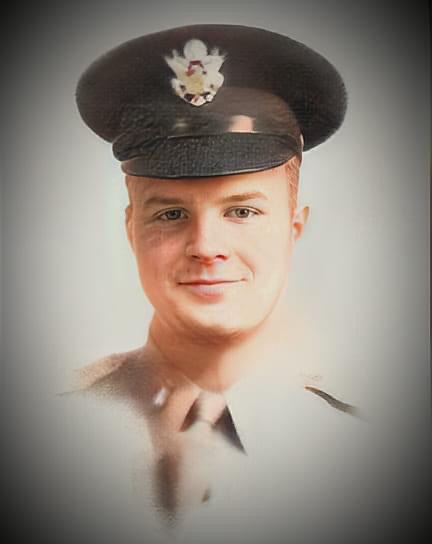
“Wild Bill Young” was born June 23, 1921. In his youth, the Young family moved to Staten Island, New York. He and his brothers became avid baseball fans by walking or riding the back bumper of a bus the length of Manhattan. He was in the Youth Aviation Corp. He graduated from Cornell University and joined the Army Air Corps at the beginning of the war. During World War II, he was a captain in the Army Air Corp and flew 51 missions in addition to the requisite 25 bombing missions as Captain of a B-26 Marauder based in England. He was called “”Wild Bill”” due to his flying capabilities, escapades, and the ability get things done, whether or not convention was involved. – excerpt from obituary.
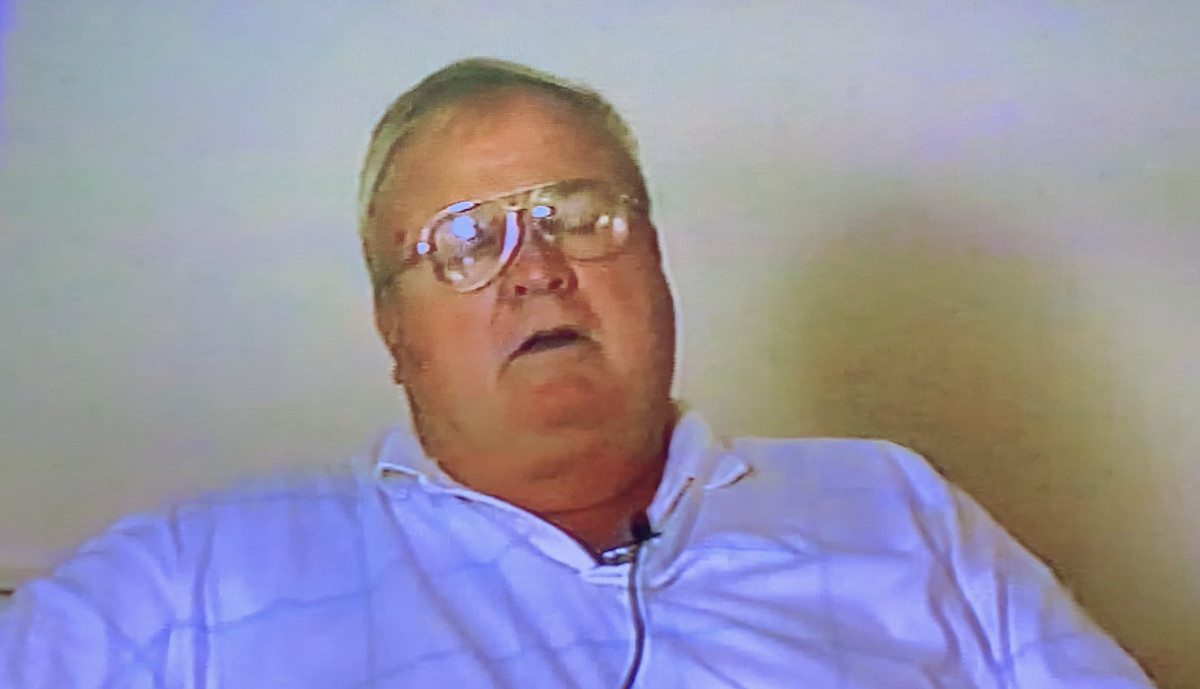
See video interview of William Nelson Young
Antics credited or allegedly accredited to “Wild Bill Young”
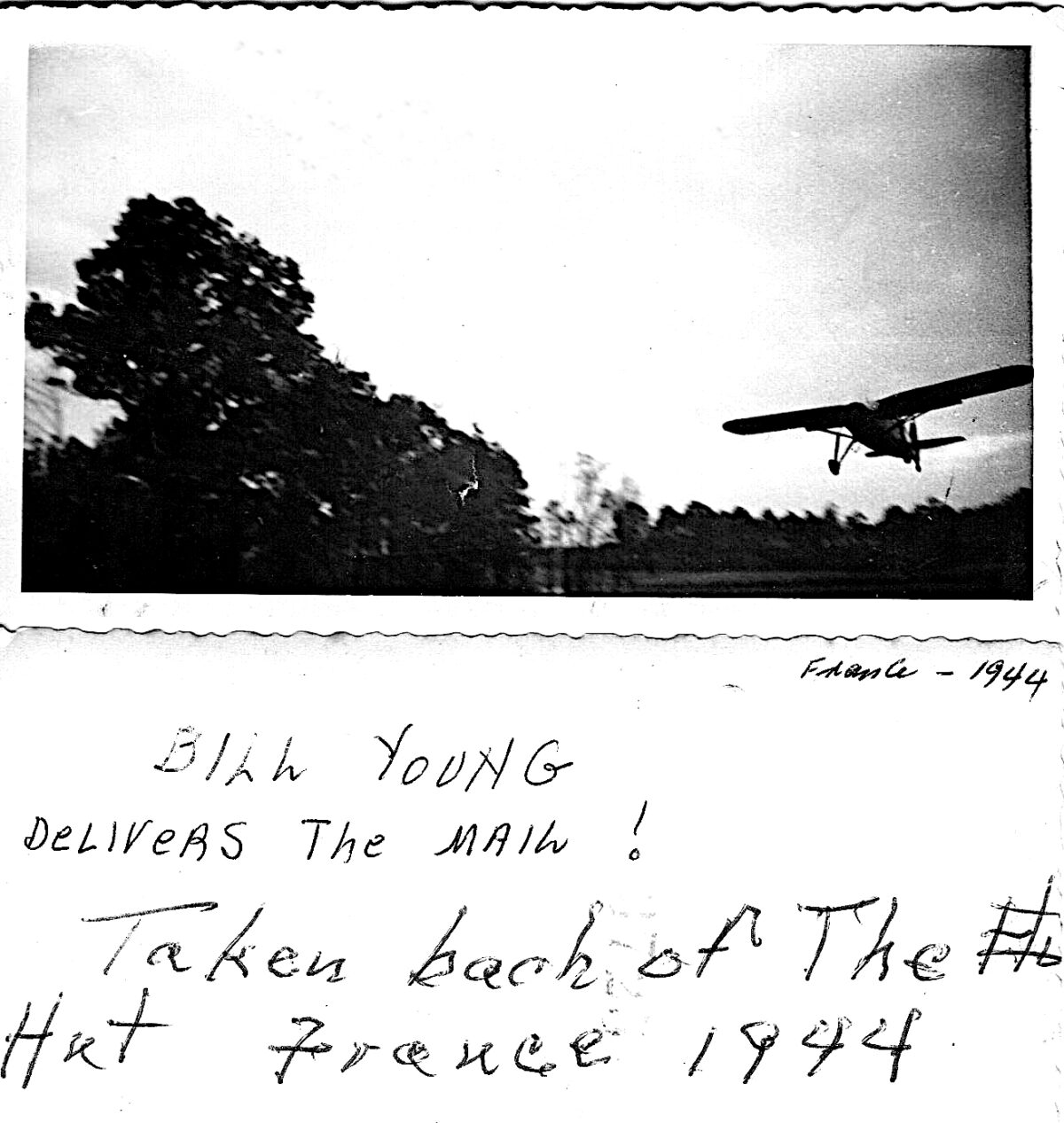
“Wild Bill” Young According to Carl H. Moore
One of the stories brought back from Barksdale by the pilots involved Lt. Bill Young. It seems that Lt. Young was a very skilled pilot but a bit bored with shooting landings and cruising over north Louisiana.
For excitement he would see how close he could come to cattle, horses, or farmers on the ground. His buzzing became well known, and finally a complaint was filed. As a result, Lt. Young was hauled before a court martial.
During the trial his crew chief was called to testify. He was giving full support to Lt. Young’s ability and finally the prosecutor asked, “Sergeant, what would you do if Lt. Young said he was going to fly through a barn whose doors were open on both sides?” Without hesitation the crew chief replied, “How wide are the doors?”
Verdict? Send Lt. Young and his crew to Europe (which is what he wanted anyway). Leaving Barksdale with his Marauder loaded to the hilt for overseas, he climbed a few thousand feet, cut one engine, feathered the prop, and buzzed the tower on one engine.
My personal encounter with Lt. Young was much later at an air base in France. He was up in an L-4 (Piper Cub) and caught four of us walking from operations to our quarters. He repeatedly had us “hitting the dirt” as he chased us with the L-4. We didn’t really think he could hit us, but we couldn’t be sure.
“Wild Bill” Young According to Korky Korkowski
Wild Bill Young was a fantastic pilot and a good friend until he died about 10 years ago. He became a doctor after WWII and practiced on an island off the east coast. I last saw him in Washington DC when he retired a few days before his death.
He was well known for doing dangerous things in airplanes around Barksdale Field, La and Paris France. We were B-26 pilots both places. He was charged with buzzing many times. Once before going overseas in WWII he paid a fine for buzzing and he told me that when he went overseas the military dropped about 10 buzzing charges. Rumors put that figure at 17.
As an instructor pilot he gave me a required flight test. He said he knew that I could fly so we would try to learn something new about the plane. We tried to see how fast we could go in a dive and then we buzzed the commander’s tent.
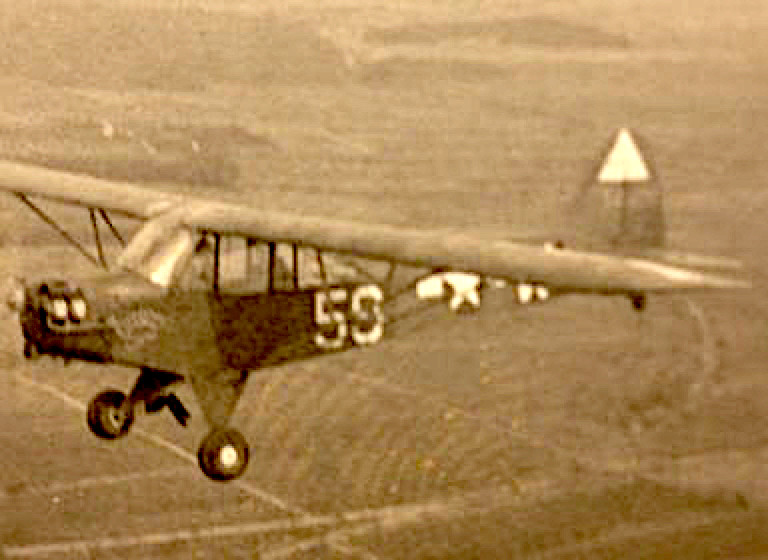
After a fresh snow, he made a bunch of snowballs and took a small plane we called a grasshopper and bombed some tents.
Bill Young lost an engine on a mission and couldn’t get his gear down yet he buzzed the commanding officer’s tent before crash landing.
There was a lot of gossip that he flew under the Eiffel Tower (Verified by his son William Young). The gossip was that he told reporters ahead of time where they should be to get the best pictures. From that spot it was not possible to get a picture of the number on his plane so nobody got a picture so he wasn’t charged. I have always doubted that he made such a flight.
Bill showed me how to sneak into our base if you have lost your instruments and the weather is down even if you start above the clouds in a mountainous area. He showed me what to do in desperate situations.
For example, “Wild Bill” Young had taught me that the B-26 did have a glide slope! This became important when landing the B-26 “dead stick” returning from another mission. I reported being low on fuel so the tower asked me to circle over the field while they landed other planes that were severely battle damaged. Then I reported running out of fuel on one engine. The tower said to continue circling because they still had one severely damaged plane to land. Then I reported running out of fuel on the last engine and the tower said, “You are number one to land”.
“Wild Bill” Young According to his son, William Young
…another expression I just recalled from his crew was …. “Messing with Wild Bill Young is like jacking off a wildcat”
From Barksdale near Shreveport he strafed Waves marching near Stillwater Ok. Although warned he then strafed a group of PT boats practicing on Lake Pontchatrain and one sank, one tipped over. That led to a hearing where he was alleged to have conducted unsafe operations. His Co-pilot Curt Seyboldt testified on his behalf. When questioned, he affirmed safe operations. Upon further questioning he was asked “If Captain Young asked his crew to fly through a barn with open doors, would the crew mutiny.?” Seyboldt replied “How wide are the doors?” As a result of the hearing he was shipped off to England to help AAC “train Brits” prior to official entrance of USA to WW2.
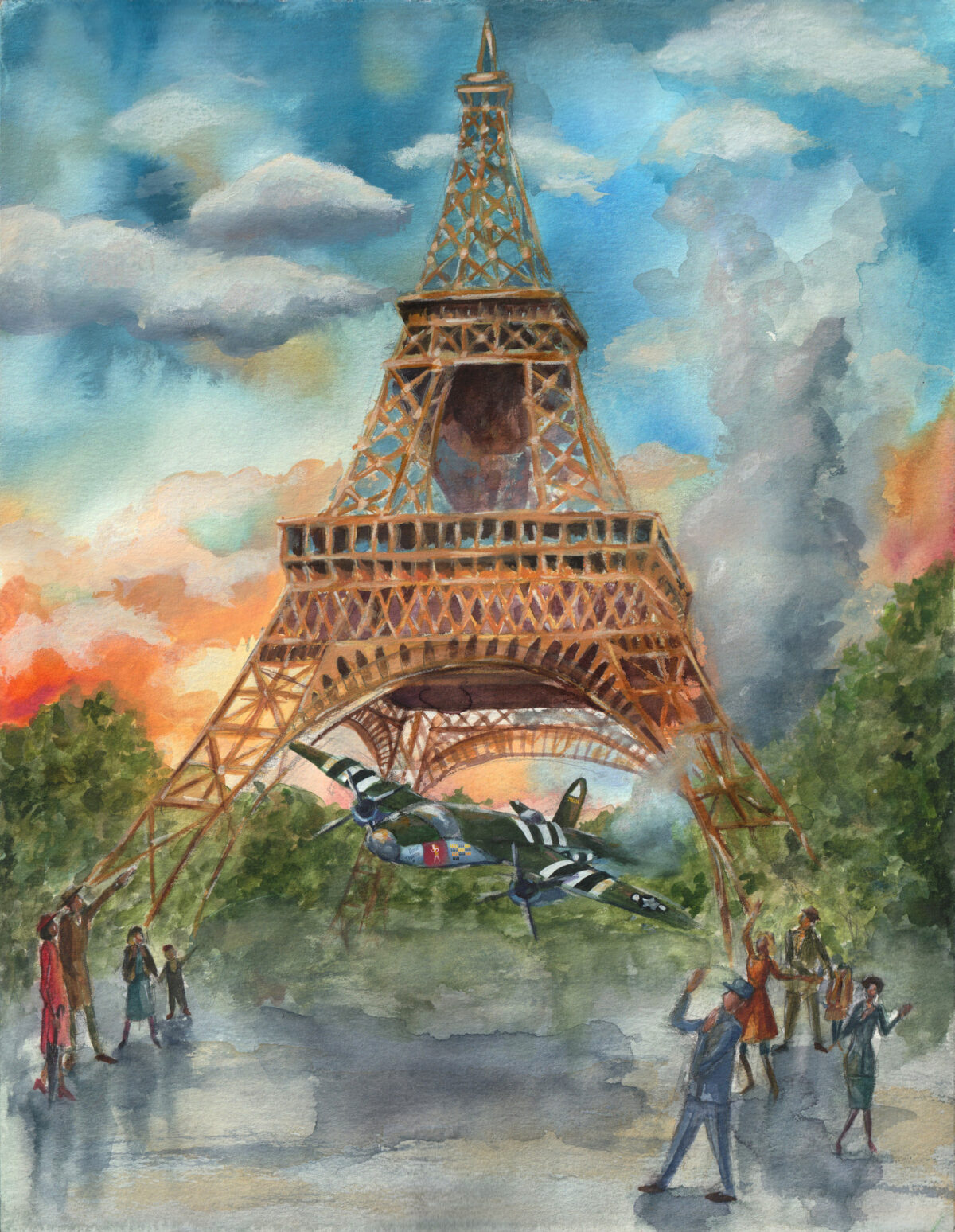
I can confirm his flying under the Eiffel Tower. – William Young Jr.
“Wild Bill” Young according to Marauder Thunder Newsletter
Three Bridges
I’ve had conflicting reports about this feat. The first was a phone call. The caller, whose name I have misplaced, said that this did not happen. According to him, there was a hot B-26 jockey who wanted to fly over the first bridge, under the second and then over the third.
This pilot surveyed the situation carefully. Apparently there are serious curves in the river between each of these bridges. This hot pilot flew down the river to determine what would be required to negotiate these turns. Then he picked out three clouds that simulated the bridges and tried out his plan. He determined that it would not work, so never tried it.
The second report came from John R. Ladd, who tells of a pilot whom he identifies as “one of the hottest pilots to fly the B-26, “Wild Bill Young.” John credits Wild Bill with the three bridge feat and goes on to tell of many of his circus tricks, some of which certainly sound like late night “hospitality room” stories. We’ll quote some:
“He once killed a horse with a prop blade. Now that’s flying low. “Wild Bill” said it wouldn’t have happened if the horse hadn’t reared up. The owner of the horse was very angry!”
“Then while on a gunnery mission on the Gulf, his crew shot up some Navy Navigation buoys. Wild Bill says that’s not true — it was a light house.”
“He frequently buzzed a field on single engine, pulled up in a chandelle, turned off the good engine and came back to buzz on the originally feathered engine.”
“While with the 450th Sqd. 322nd BG at Great Sailing, England he was known to feather both engines at 12,000 feet. He determined that we could establish a glide at 180 MPH at 500 feet per minute. He knew that he could make it across the channel.”
“Wild Bill” Young according to “Wild Bill” in a letter to Marauder Thunder.
Dear Editor (by William Young)—Marauder Thunder
I am very pleased that at last the name 1st Lt. William N. Young, Jr. will be dissociated from Wild Bill Young.
When I landed at Barksdale, My C.O., mentor and spiritual advisor, Capt. Robert E. Herndon ran up to my plane. As I disembarked, he yelled, “You’re grounded!!”
This caused me to turn to my barracks legal advisor, Sgt. Fedderwitz, and ask, “Do you think we nicked someone?” Feeling weak in the knees I reminisced, I was returning from the Naval Reserve School, Stillwater, Oklahoma.
There I was led down that primrose path by several comely patriotic WAVEs in training to become officers. I was quite proud of my B26 Marauder and bragged about her twin 2000 H.P. P&W engines. A blonde said, in a very southern drawl, “It’s just a little Ole bombbbuh.” Another said laughingly, “Jimmy flew the P40 and wagged his wings n’ thrilled us to death when he flew over our drill parade. He had a cute, fast plane.”
I told them, “Anything a P40 could do a B26 could out perform.”
This was greeted by raucous ridicule, “That big thing?” – “You’d be lucky to get it over the campus.”
When one girl said, “Look at how clumsy it is”, It felt like I’d just asked a girl to go to the Prom in a ton and a half truck. I was goaded ’til I said, “I’ll fly over your parade at 10 a.m. tomorrow and you can judge which is more thrilling.”
Without any idea where the jousting field might be, we soon found O.S.U. and found them in their natty blue uniforms smartly marching like Preflight Cadets. We dropped to 500 feet and I gave three opening and closing of throttles, they stopped marching and waved.
The quadrangle was long and narrow with academic buildings on either side and trees on the ends. We chopped leaves and came in at the level of the building roofs. No wires. On this pass all the WAVE’S hit the dirt. Feeling that WAVE’s would react like infantry women, we decided to buzz them. Since we didn’t know how low the P40 had flown, we buzzed at the level of the 2nd floor and every Naval uniform was navel to the deck. The plane lifted to 1000 feet and hightailed it to Barksdale.
I was afraid that something had happened to one of the budding officers. I ventured, “NONE of the girls were hurt, were they? No answer, I became more uneasy by the minute. Capt. Herndon stated, “You flew under a bridge.” I was so relieved, I answered, “Not recently, sir.”
I was not read my Miranda Rights. I then wrote my confession of flying under the bridge for my C.O. and thought that this event would be forgotten. Finally I found out that there were no calls from Stillwater. Later that night I called the school at Stillwater and the report was, wet panties, grass stained knees, elbows and uniforms but no other injuries. I felt greatly relieved.
That is the end of the violations of 1st Lt. William N. Young, Jr. and it is to be noted that he was not found guilty of dangerous, negligent, careless, or foolish operations of a B-26.
Not guilty Paragraph 1 and Paragraph 16 a (1)(a)(c) and Paragraph 16 a (1)(d) and Paragraph 16 a (2) of AAF Regulation 60-16.
Totally rehabilitated by working for three months on the ground with no flight pay and a fine of $50.00 per months for three months, the Lt. decided to be very careful of AAF Reg.60-16 as his lawyer advised.
As an example I was given permission to fly low down the runway when I left Barksdale. Overcome with emotion at leaving Barksdale with tear-filled eyes, I inadvertently struck the right engine mixture. When it stopped, Ken Weyerbacher, my copilot and a natural brilliant pilot, reflexly feathered it.
So there we were in an authorized buzz job. The left engine apparently pulled the plane right at the control tower in a steep turn into the dead engine. We lifted the dead engine over the control tower, said good bye on the radio, then turned it off. Once again virtue had triumphed, we corrected, pulled up to altitude and proceeded to Hunter, Florida and Savannah, Georgia.
It was at this point that the myth of “Wild Bill Young” was born. Everything done after Barksdale, Wild Bill Young is guilty of AAF regulation 60-16 violations. I believe he was operating in the Barksdale vicinity especially at night.
At the Ruston WAC Camp, the Provost Marshal (PM) set up a
trap to catch the night prowler who came in with his
headlights on. I am suspicious that Wild Bill or some kindred soul dived at the PM and his assistant in two towers at the WAC Camp.
When my lawyer asked him, “Did you get any numbers off
the plane?” The PM said, “My assistant and I turned off the search lights and got out of the towers.”
To finish off the PM, my lawyer asked him to go to the court room window and asked him to look at the flagpole. The PM returned from the window and said, “Sixty feet.”
My lawyer continued, “My question is not how high the flag pole is, but how far it is from the road.” Of course, the policeman did not know.
The Red River Bridge scene was more of the same by Wild Bill. Grover Ted Tate wrote in a book “Bombs Awry” Wild Bill was not adverse to using his landing lights at drive-in movies.
After I went to England, I heard of Wild Bill at the Nation’s Capitol and Washington Monument, coming in over the elevated and center field at Yankee Stadium up over the stands at home plate.
Still no recidivism for me, despite the fun that Wild Bill was having, I flew by AAF Regulation 60-16 and it remains by my Bible. As you can see, I was a publicist for the B-26 Marauder and trying to promote it to its place in history when I accepted the challenge of competing at Stillwater, Oklahoma and I reaped nothing but trouble because of my obvious violations of AAF Regulation 60-16.
I am very suspicious that Wild Bill Young whoever and wherever he may be does not have AAF Regulation 60-16.
William N. Young was indeed court-martialed for some of his stunts prior to being assigned to the war in Europe. The document below is the official record.
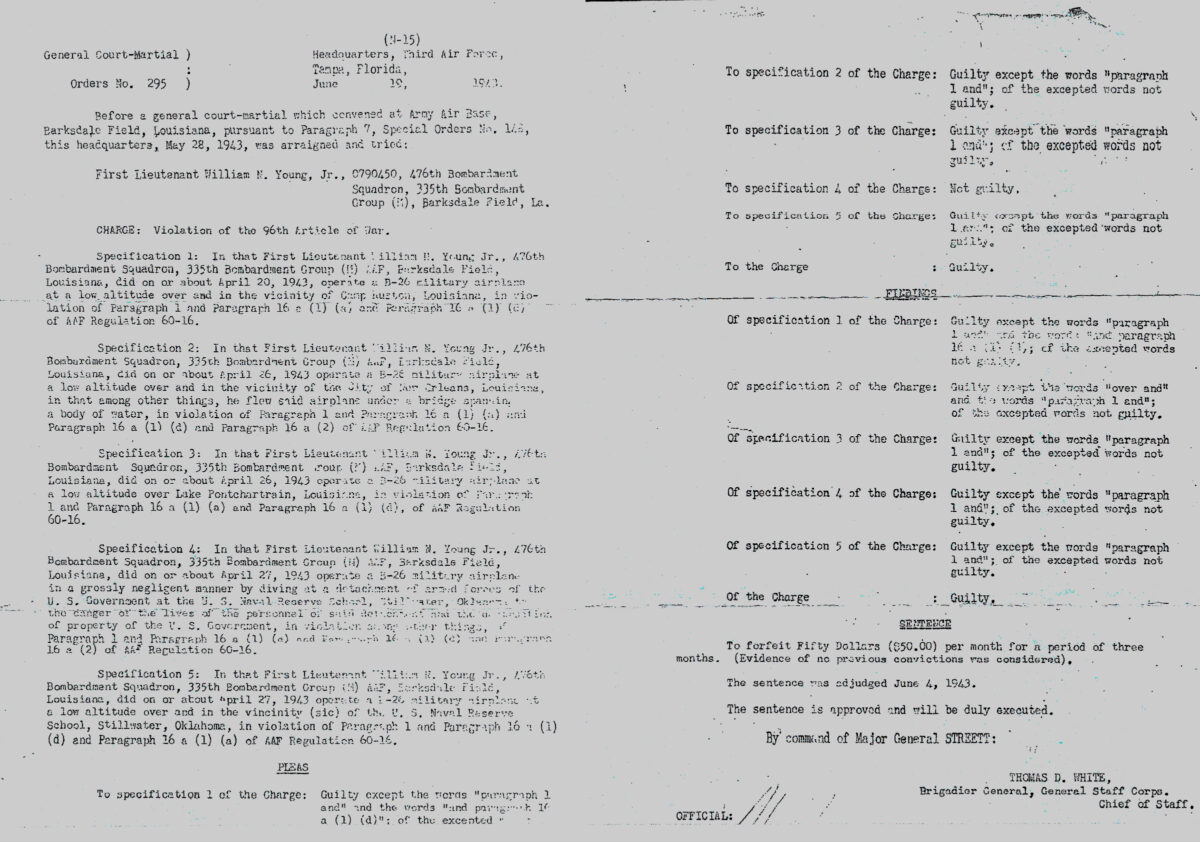
William N. Young’s Aircraft:
There were at least three aircraft named by Lt. (later Captain) Young. There was the Hearse, Hearse II, and Hearse III. The first two were when Young flew with the 322nd BG and Hearse III was a 344th BG aircraft.
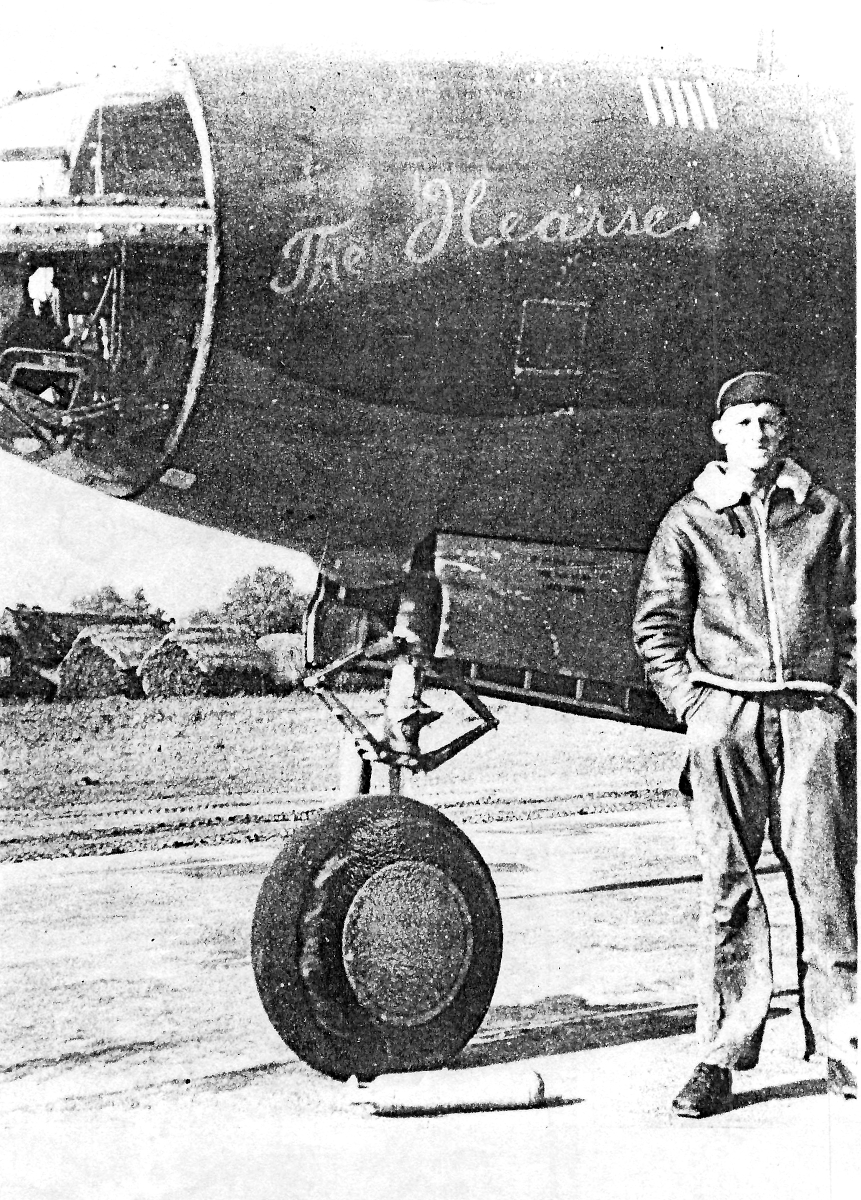
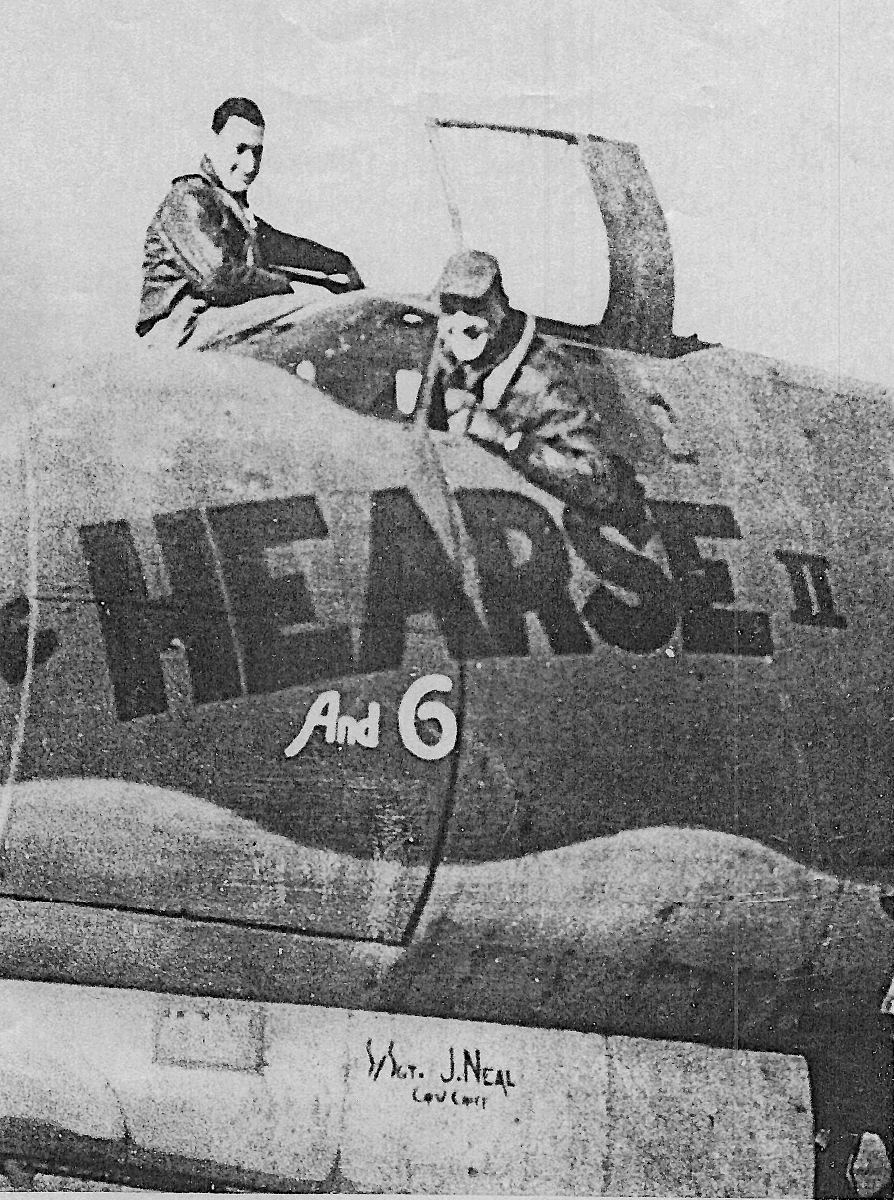
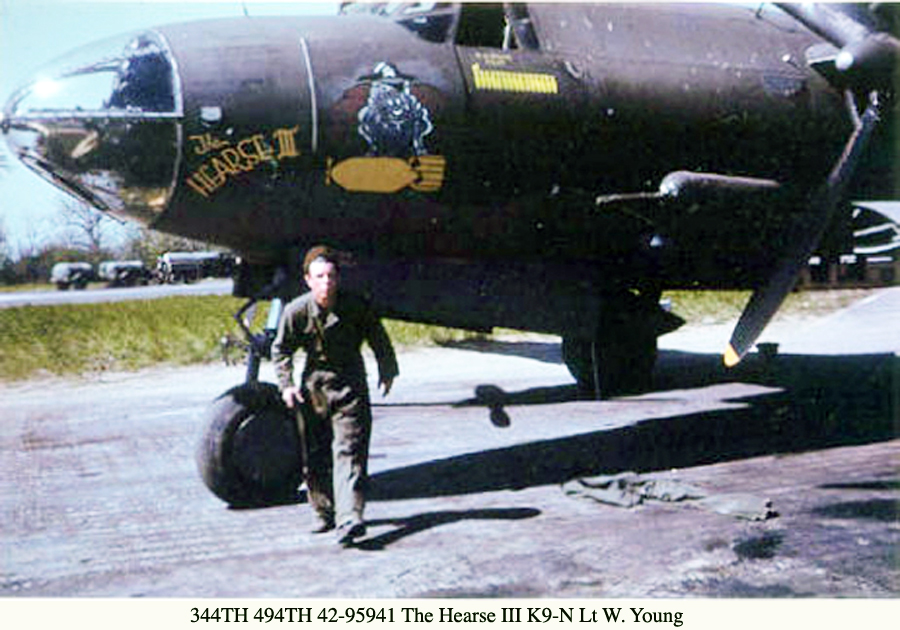
—————–
Some of Lt. Young’s missions with the 344th Bomb Group
On April 8, 1944 the target was Coxyde Airdrome in Belgium near the coast and Dunkirk.
According to 344th Silver Streaks– “
On April 8, 1944, thirty-nine planes flew out to attack a marshalling yard but the weather continued to preclude accurate bombing. The group never reached its primary or secondary objectives and turned about to return. On the way to base, the first Box unloosed its bombs on Coxyde Airdrome on the Belgium coast just north of Dunkirk, hitting in the south dispersal area. Several buildings and a hangar received direct hits as well as revetments and a refueling loop. The second Box failed to bomb and brought its bombs
home. Flak encountered that date damaged thirteen ships slightly. No casualties resulted to personnel.”
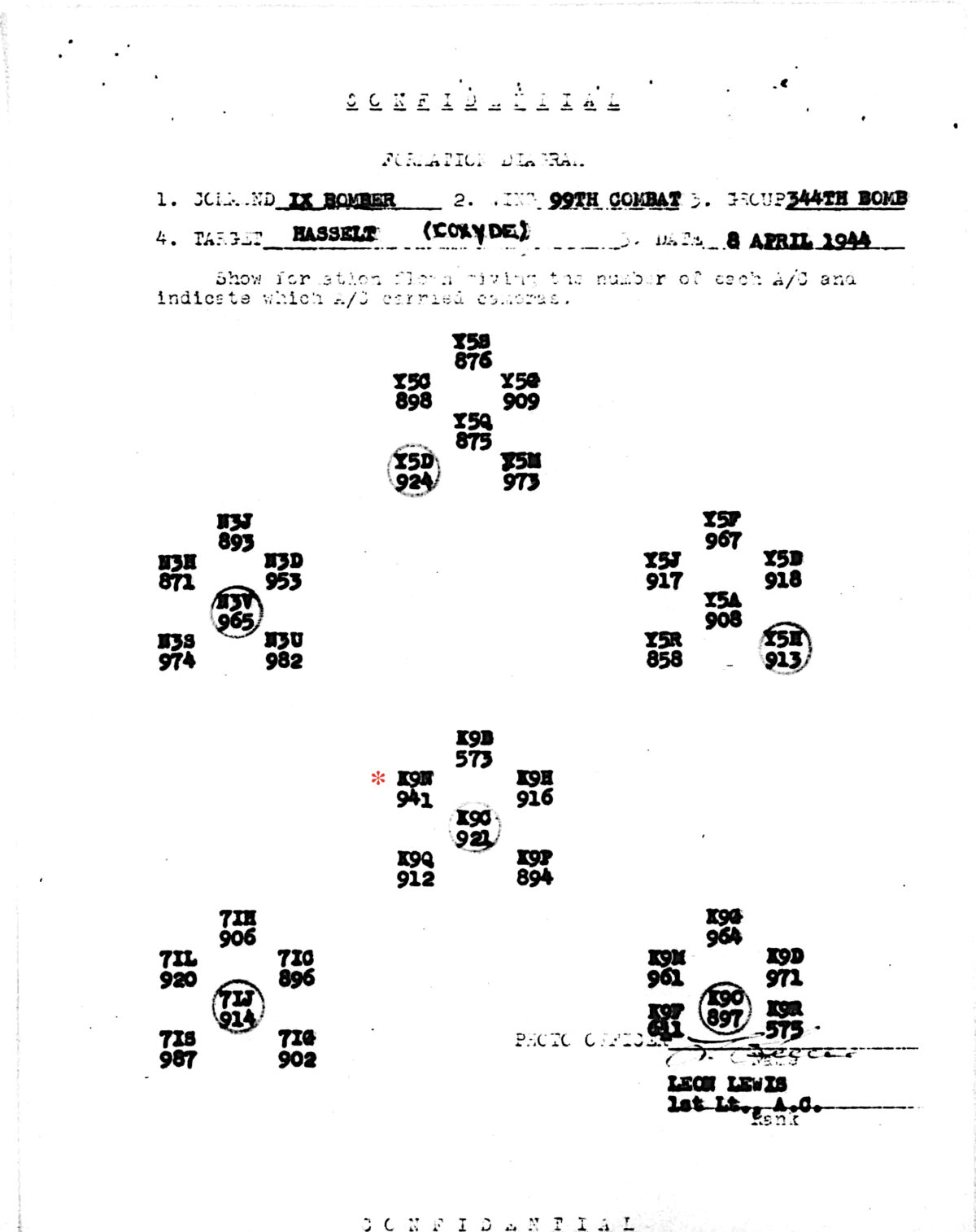
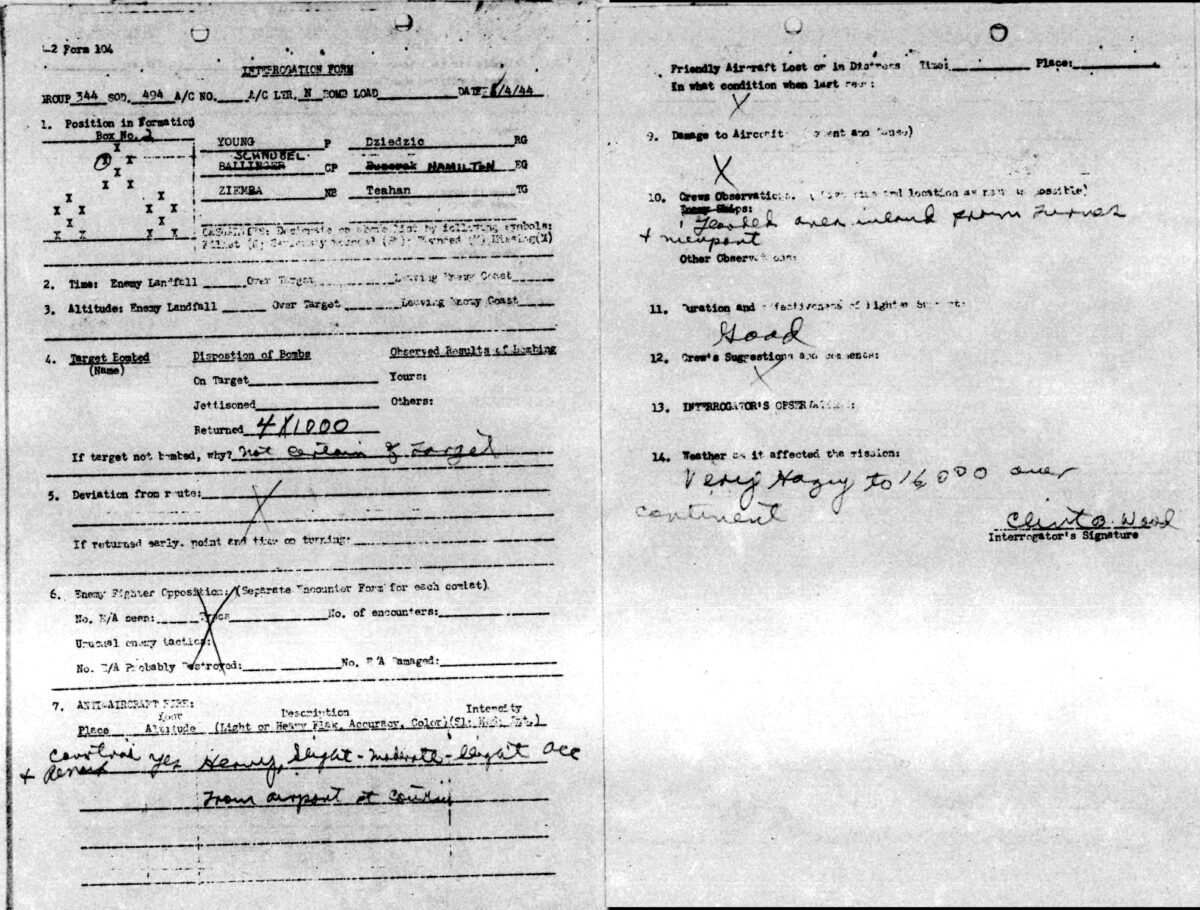
The crew included;Young – pilot, Schubel – co-pilot, Ziemba – navigator/bombardier, Dziedzic – radio/gunner, Hamilton – engineer/gunner, Teahan – tail gunner.
They carried 4 – 1000lb bombs that were returned to base when they were uncertain of the target. The flak they experienced varied from light to heavy and was accurate. The skies were hazy up to 16,000 ft over the continent.
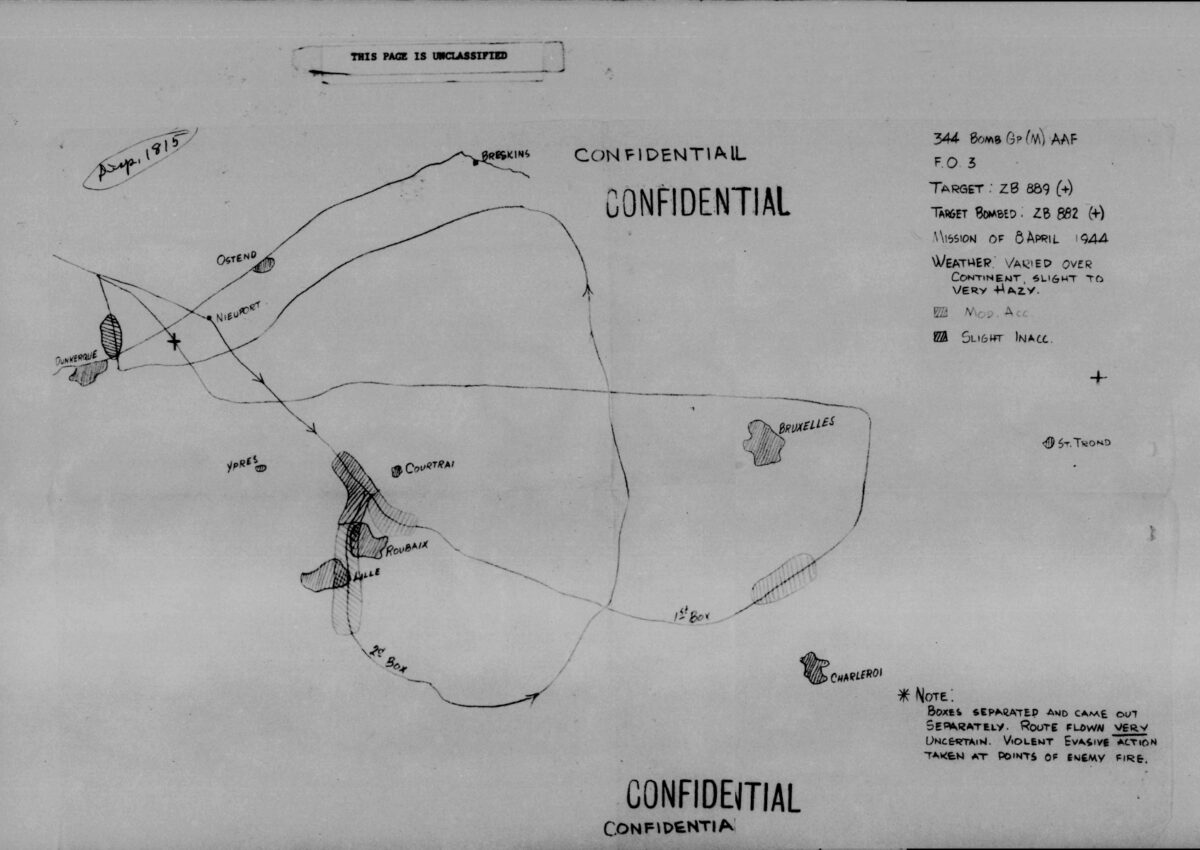
The map inset states that the boxes separated due to violent evasive action.
——————–
Lt. Young flew two missions on April 10, 1944.
According to 344th Silver Streaks– “Our next participation in Air Force plans was April 10, 1944. two missions were flown that day. The first was to attack a coastal gun battery at Le Harve/Le Clos on the French coast. Of the forty planes dispatched, thirty-nine harmlessly dropped 155 X 1000-pound
bombs in a field near the town of Marfanville some two miles distant from the gun position.
The first target was a gun battery near Le Havre/Le Clos on the French coast.
Their is no formation diagram for this mission.
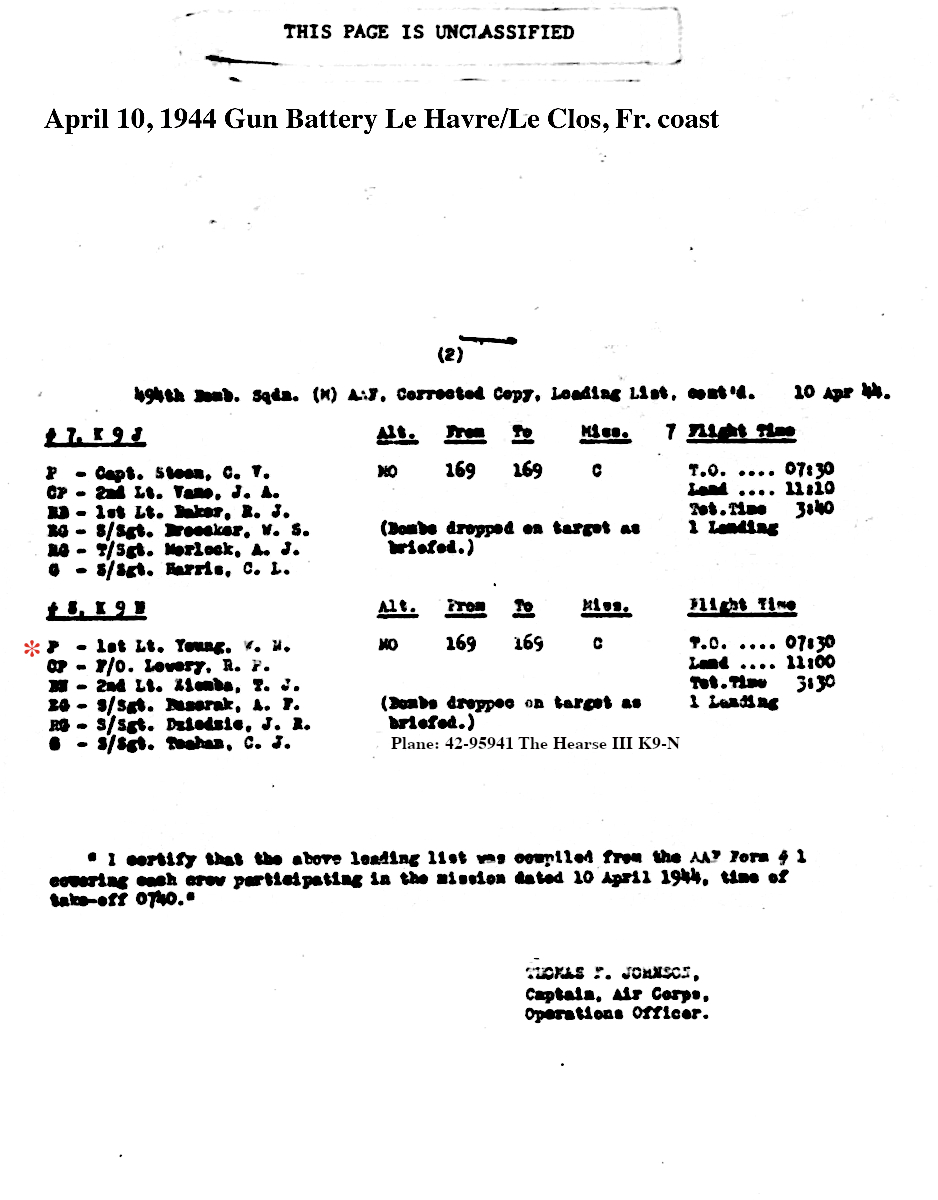
Their bombs were dropped on target.
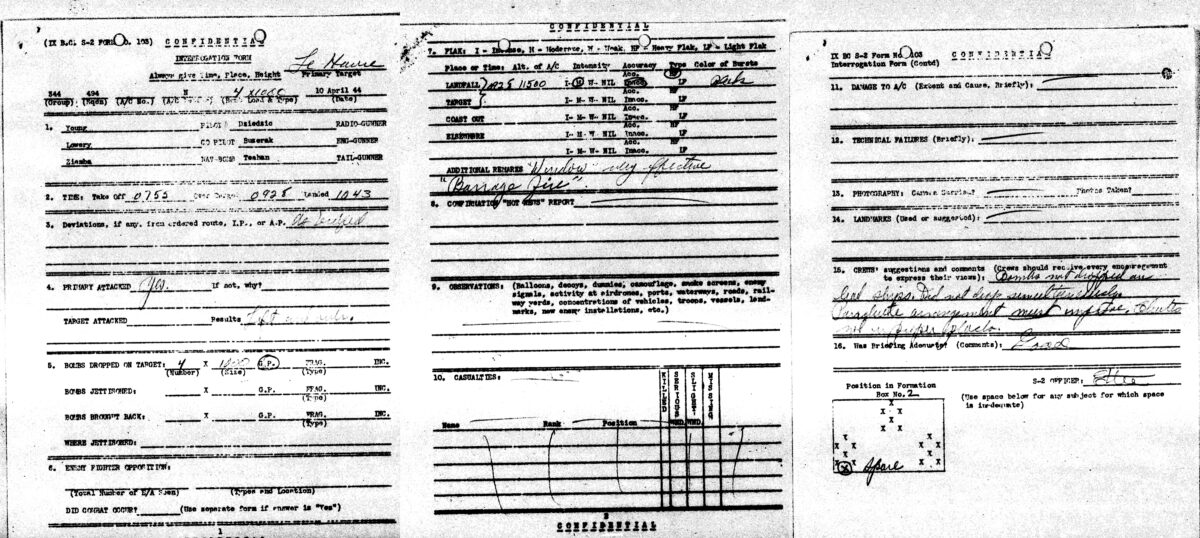
The debrief lists the crew as; Young – pilot, Lowery – co-pilot, Ziemba – navigator/bombardier, Dziedzic – radio/gunner, Buzerak – engineer/gunner, Teahan – tail gunner.
They flew in formation position 2-3-7 as a “spare.”
At 9:28 they dropped four 1000lb bombs on the target as briefed. Inaccurate flak was experienced upon landfall and at the target. Lt. Young deemed the “Window” (dropped tinsel radio jamming material) to be very effective as he described the flak as “barrage fire.”
Young was concerned that the formation did not drop their bombs simultaneously. He stated that their parachute arrangement must improve as the “chutes were not in their proper places.”
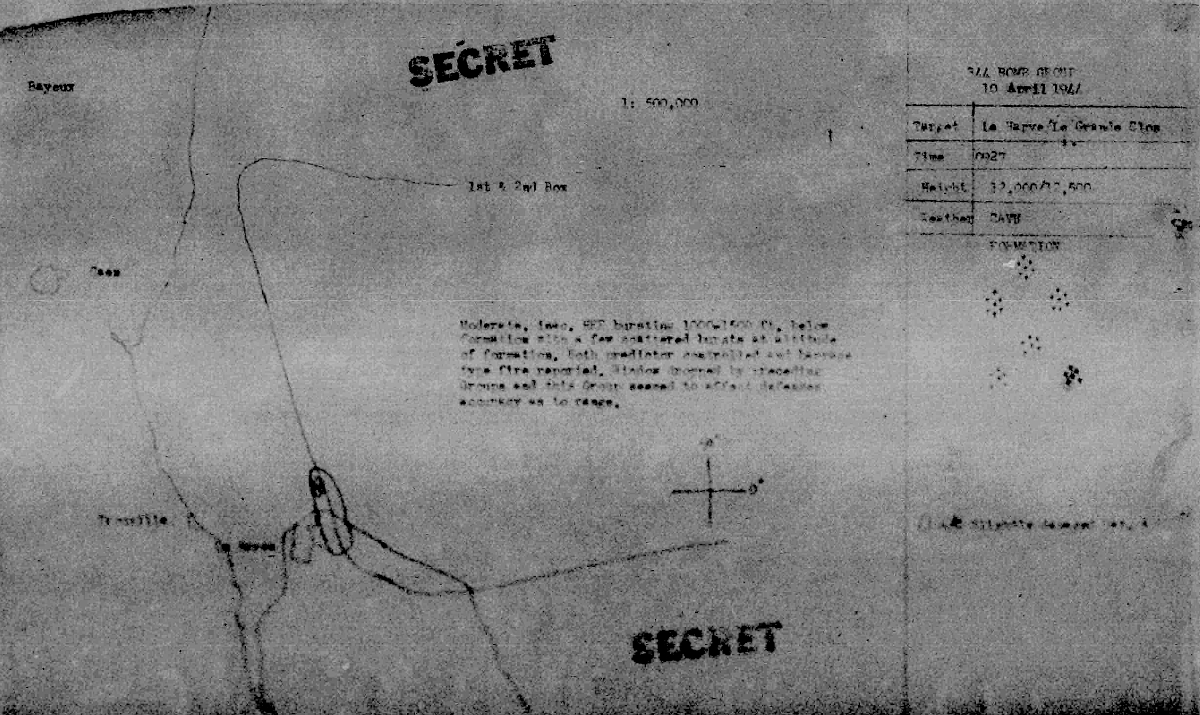
The second target on April 10, 1944 was to a Marshaling Yard in Namur, Belgium.
According to 344th Silver Streaks– “On the second mission of the day, the marshalling yard at Namur, Belgium, the group vindicated its earlier morning attack somewhat by dropping 152 X 1000- pound bombs from thirty-eight aircraft, on and near the tracks and goods wagons with good results. Some bombs went over the AP, making direct hits on paved roads south of the river and across from the railway yards.”
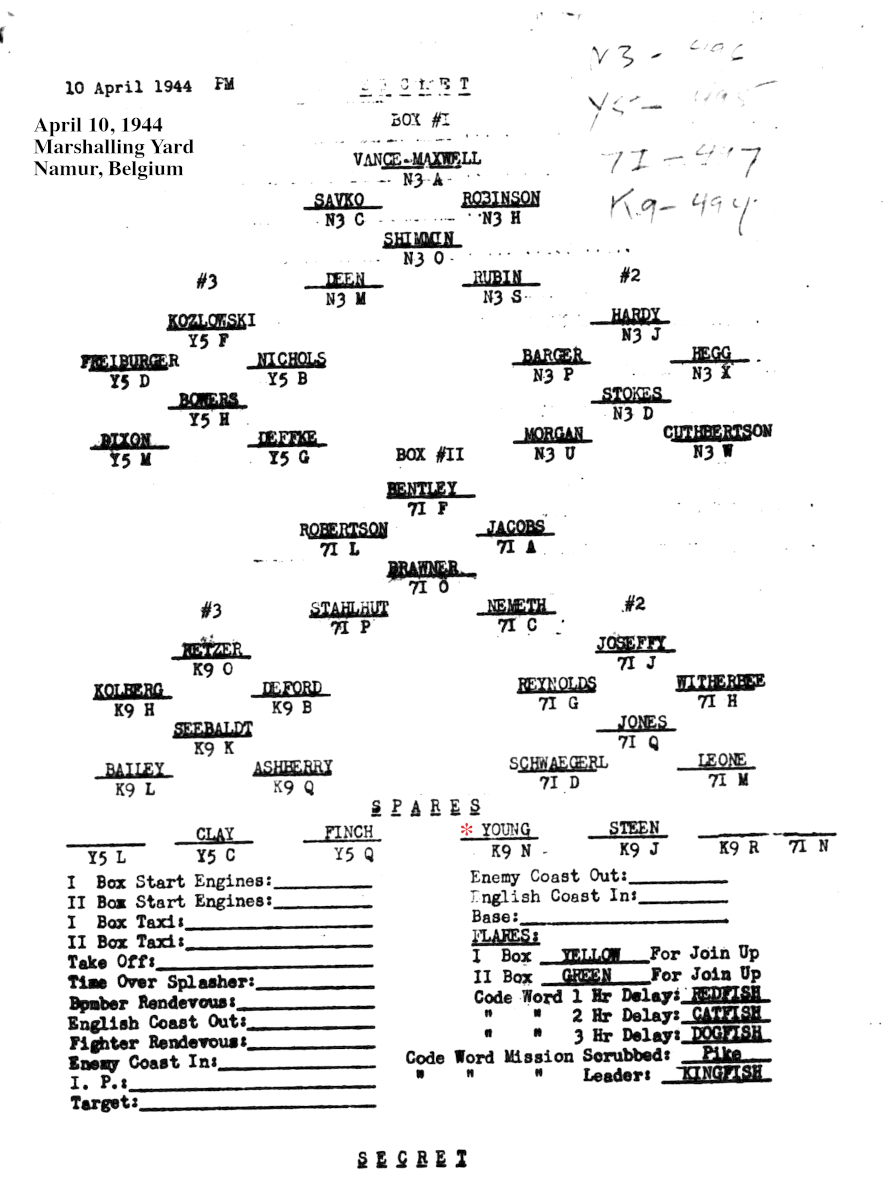
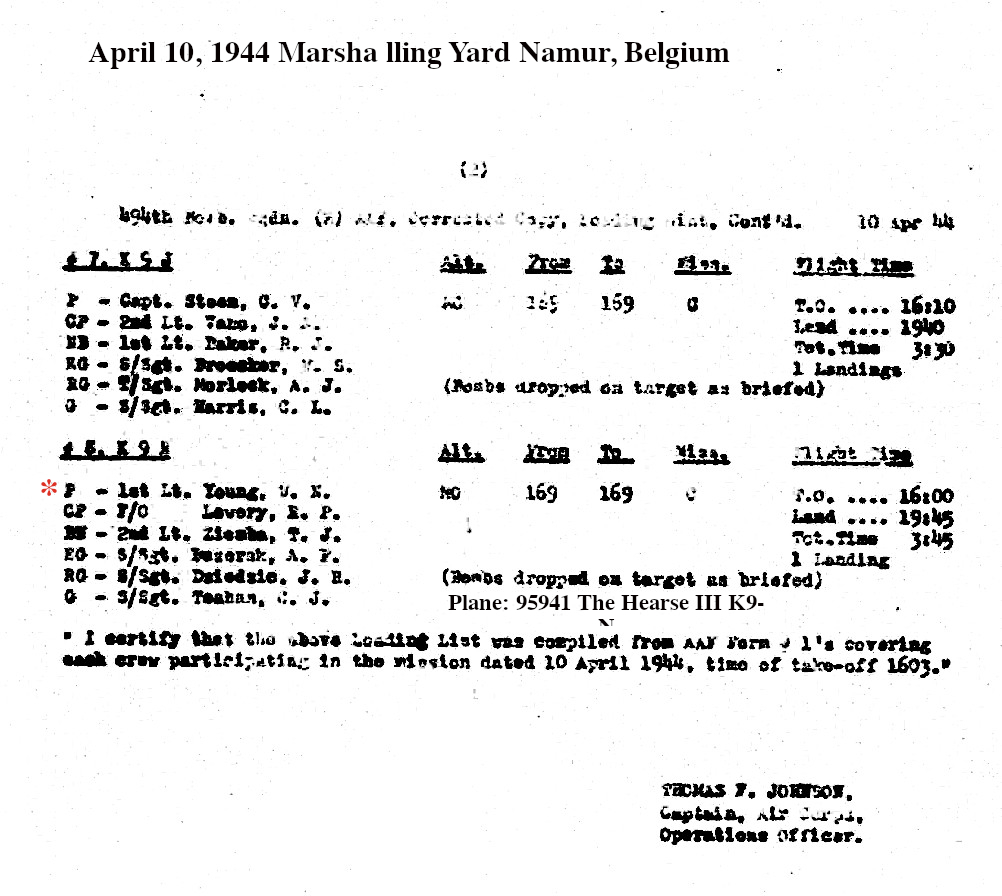
The crew included;Young – pilot, Lewery – co-pilot, Ziemba – navigator/bombardier, Dziedzic – radio/gunner, Imzerak? – engineer/gunner, Teahan – tail gunner.
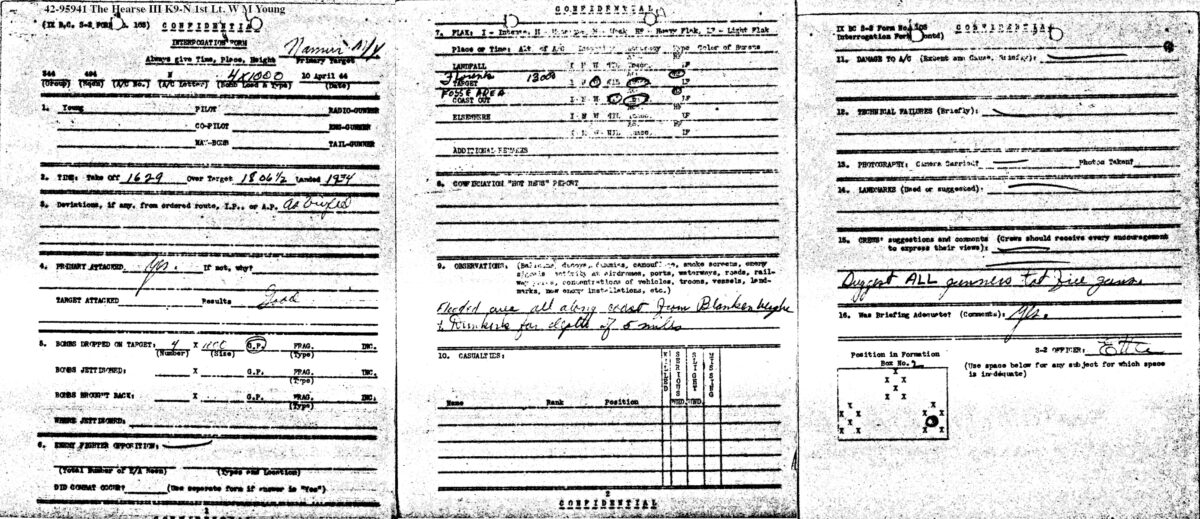
Created with GIMP
On this debrief, the crew was not listed. Lt. Young took off at 4:29 pm, was over target at 6:06pm and landed at the base at 7:34 pm. The plane assumed the 2-2-4 position in the formation. They dropped four 1000lb bombs with good results. They experienced weak and inaccurate flak over the target. Young cited flooding “all along the coast.” Young suggests that all gunners test their guns.
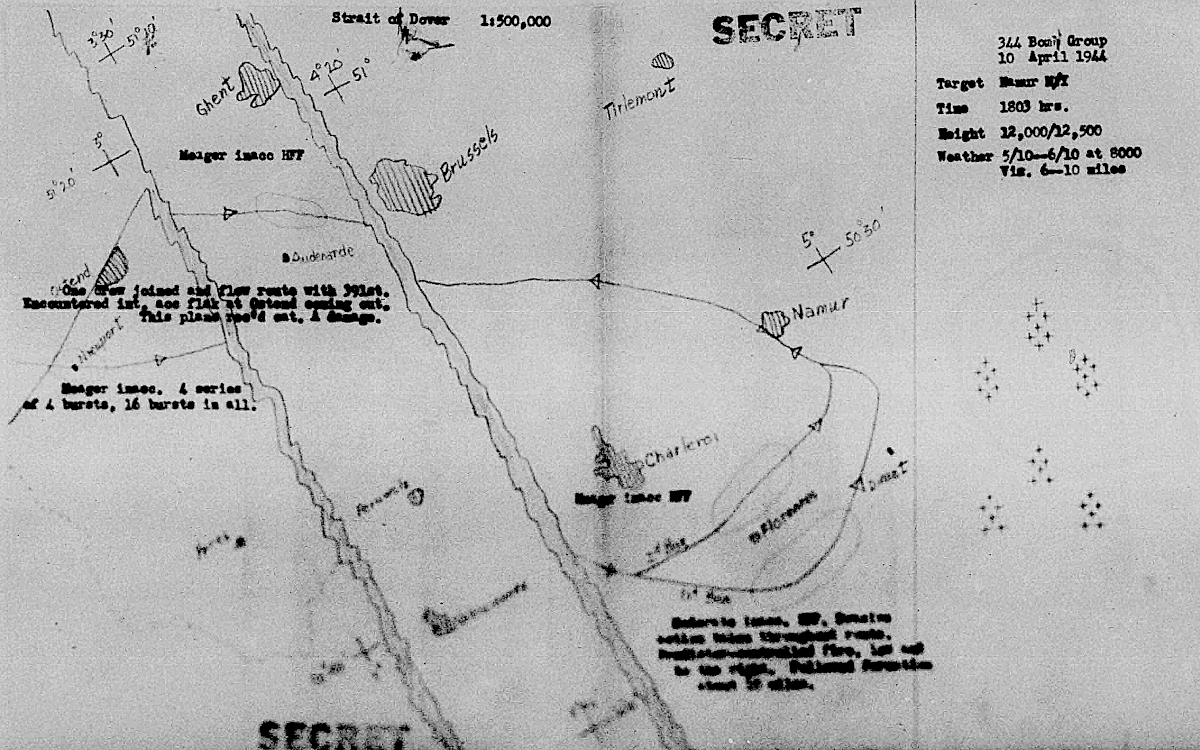
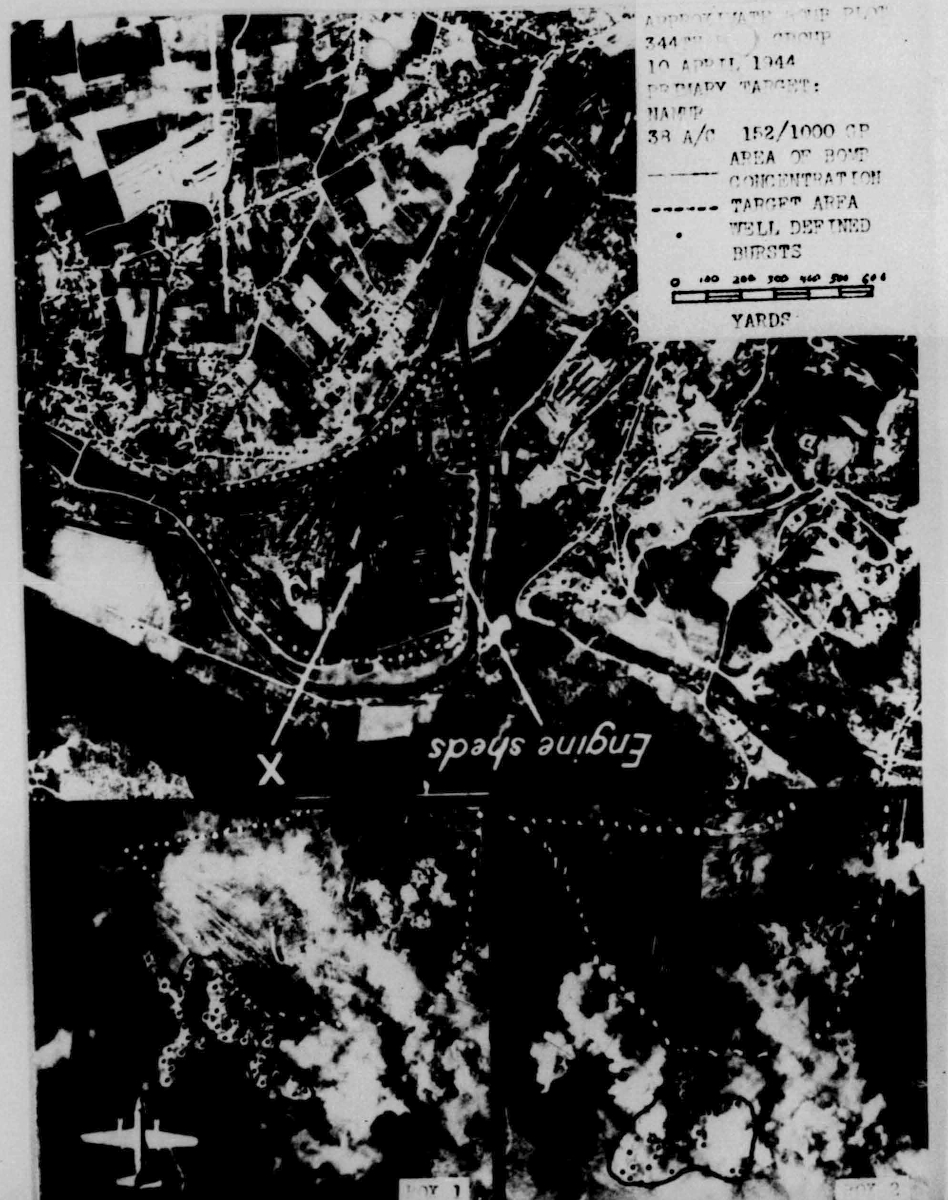
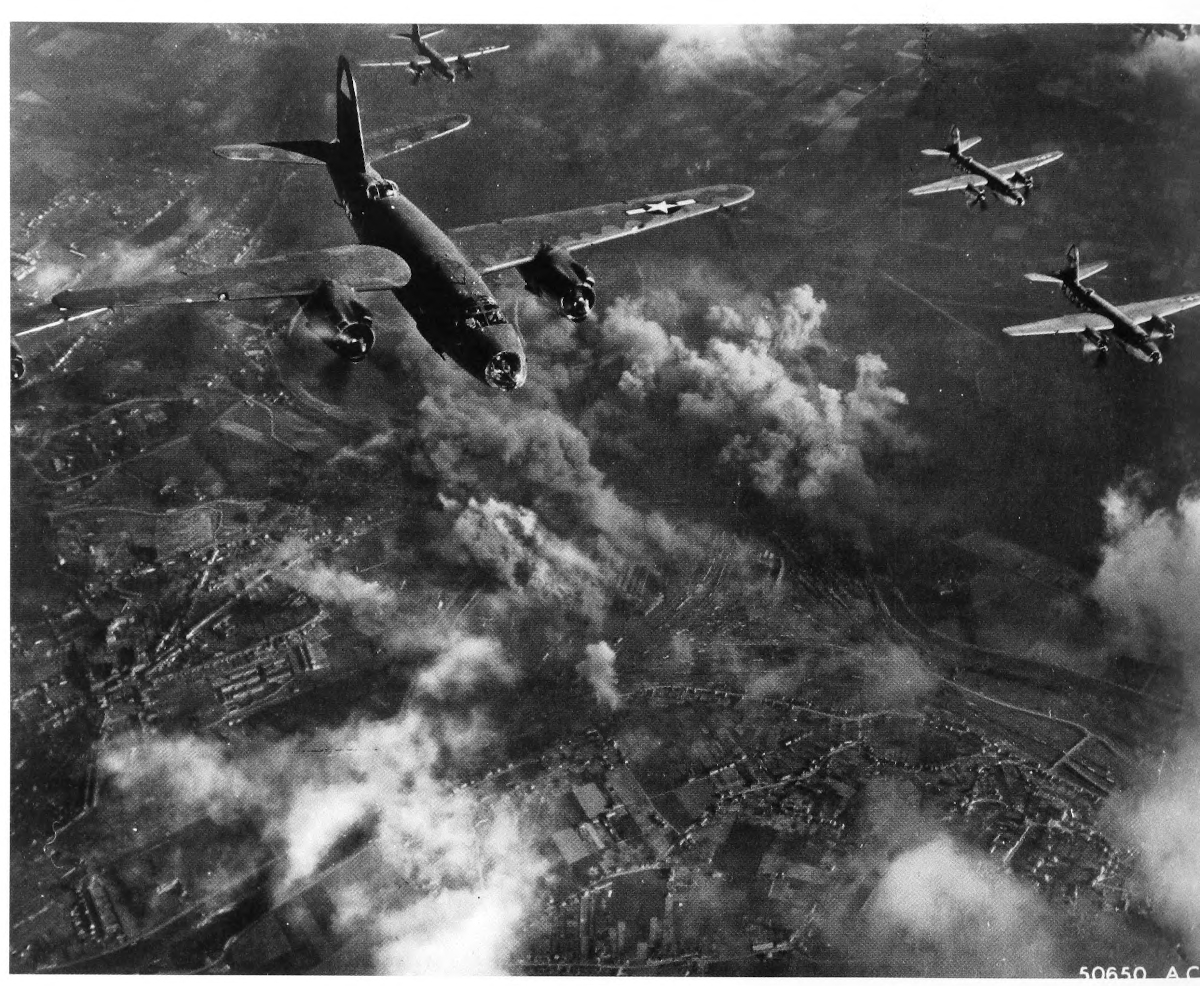
the hundred and fifty-odd B-26Marauder medium bombers of
the 9th Air Force which on April 10th seriously damaged the
railway marshaling yards at Namur, 35 miles southwest of
Brussels. The smoke rising from direct hits on the tracks and
freight cars show the kind of precision bombing the Marauders
have demonstrated in their heavy attacks against the German
transportation in Occupied Europe. Planes in this picture are
some of the unpainted system Marauders of a Marauder Group.
The natural aluminum finish, without paint, increases the speed
of the Marauder. (U.S. Air Force Photo courtesy Paul Benedict)
On April 11, 1944 the 344th bomb group targeted a marshaling yard at Montignies Sur Sambre, Belgium. No formation diagram is available.
According to 344th Silver Streaks– “The marshalling yard at Montignies-Sur-Sambre heard the roar of the “Silver Streaks” formation above it and felt the weight of its 532 X 250-pound General Purpose bombs on April 11, 1944. Photographic evidence of the results were obscured to a great extent by cloud coverage, but did show hits on a building on the south edge of the yards and near-hits on the engine shed.”
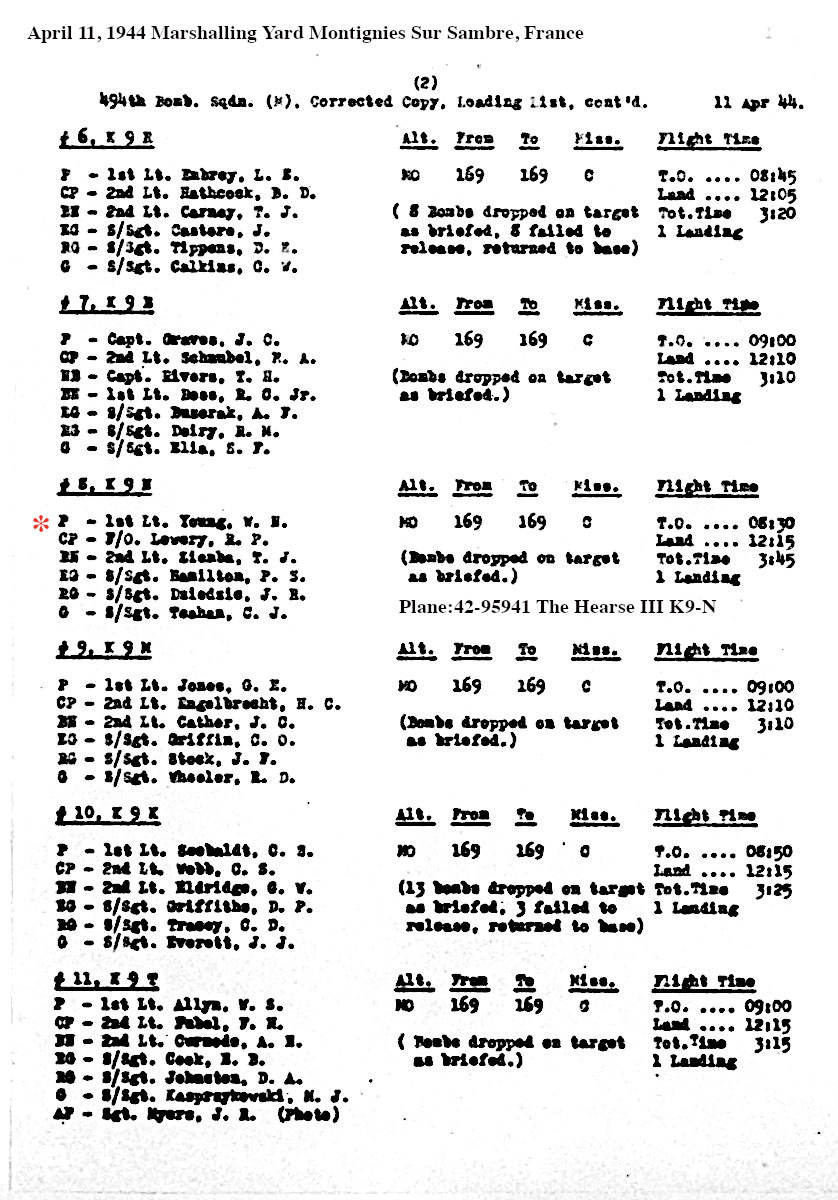
The crew included;Young – pilot, Lewery – co-pilot, Ziemba – navigator/bombardier, Dziedzic – radio/gunner, Hamilton – engineer/gunner, Teahan – tail gunner.
Take off was at 8:30 am and the landing at 12:15 pm. Their bombs were dropped on target. They flew in 42-95941 The Hearse III K9-N.
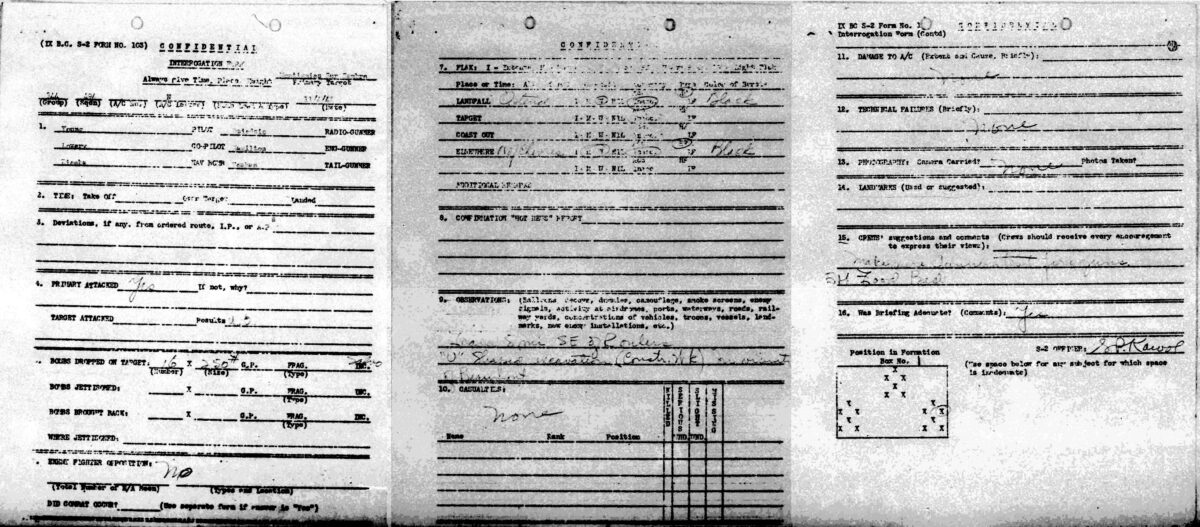
According to the debrief report, Young reports dropping 16 x 250lb incendiary bombs. No fighter opposition was experienced. Weak and inaccurate flak was observed. They flew in formation position 1-2-2.
________________
Bill Young and crew flew two missions on May 9, 1944
According to 344th Silver Streaks– “May 9, 1944, the railway facilities at Calais were bombed and good hits recorded by the automatically operated cameras in each flight.”
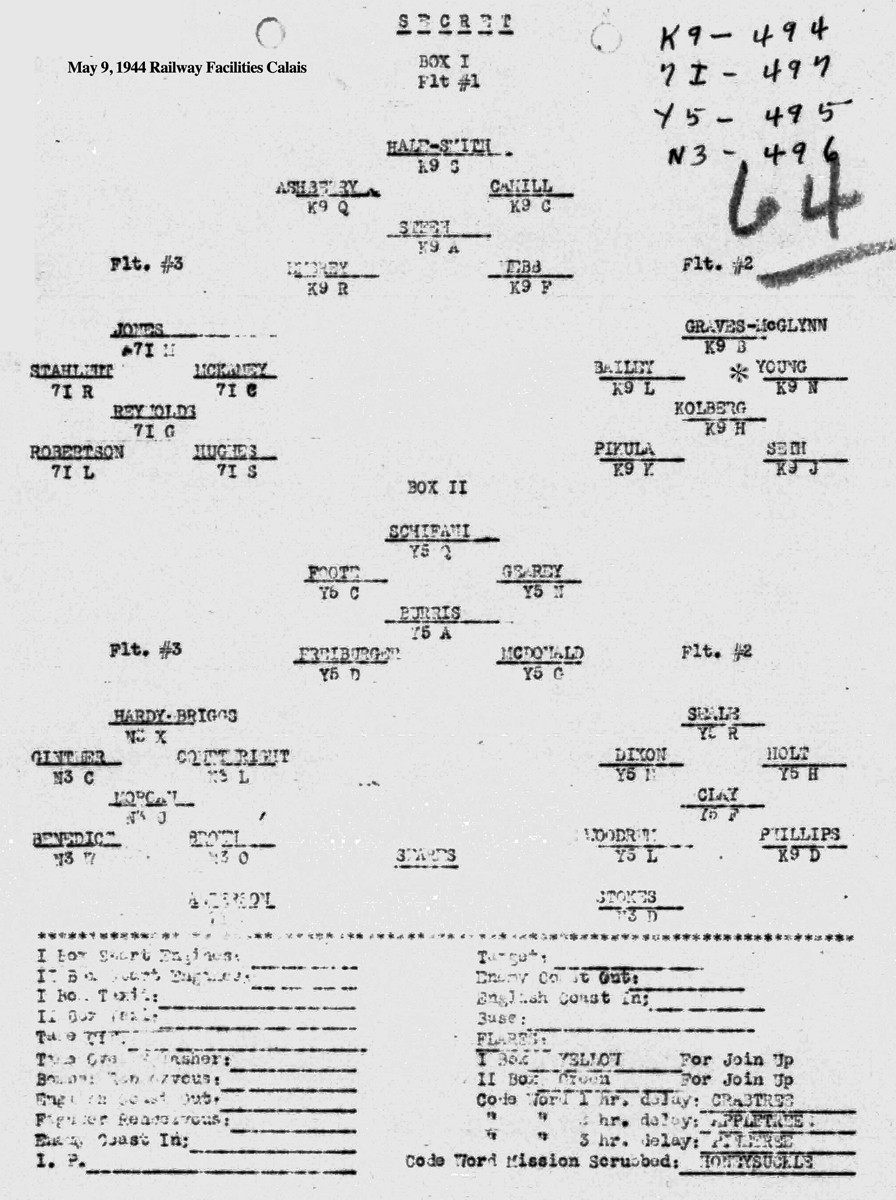
Young and crew flew in position 1-2-2 in 42-95941 The Hearse III K9-N.
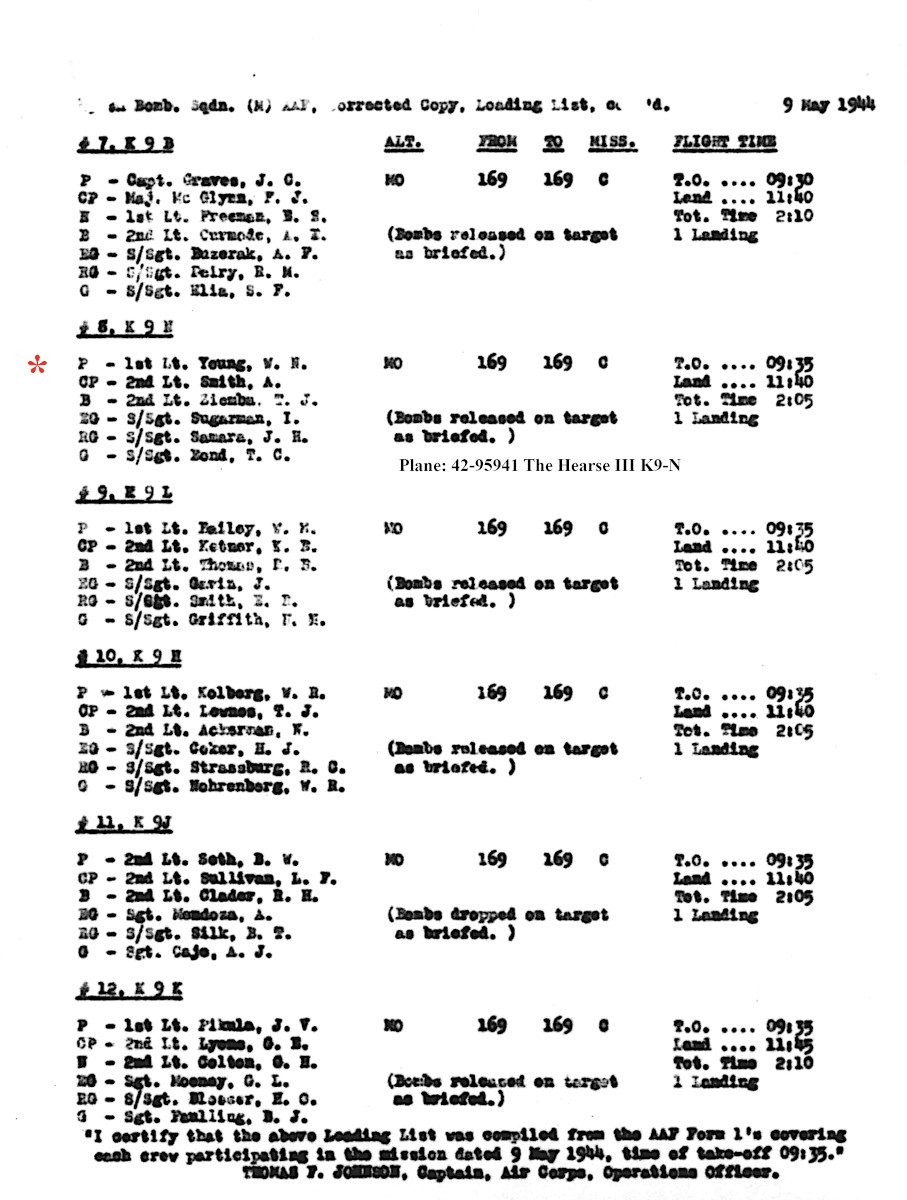
The crew included;Young – pilot, Smith – co-pilot, Ziemba – navigator/bombardier, Samara – radio/gunner, Sugarman – engineer/gunner, Bond – tail gunner.
Take off was at 9:35 am and the landing at 11:40 am. Their bombs were dropped on target. They flew in 42-95941 The Hearse III K9-N.
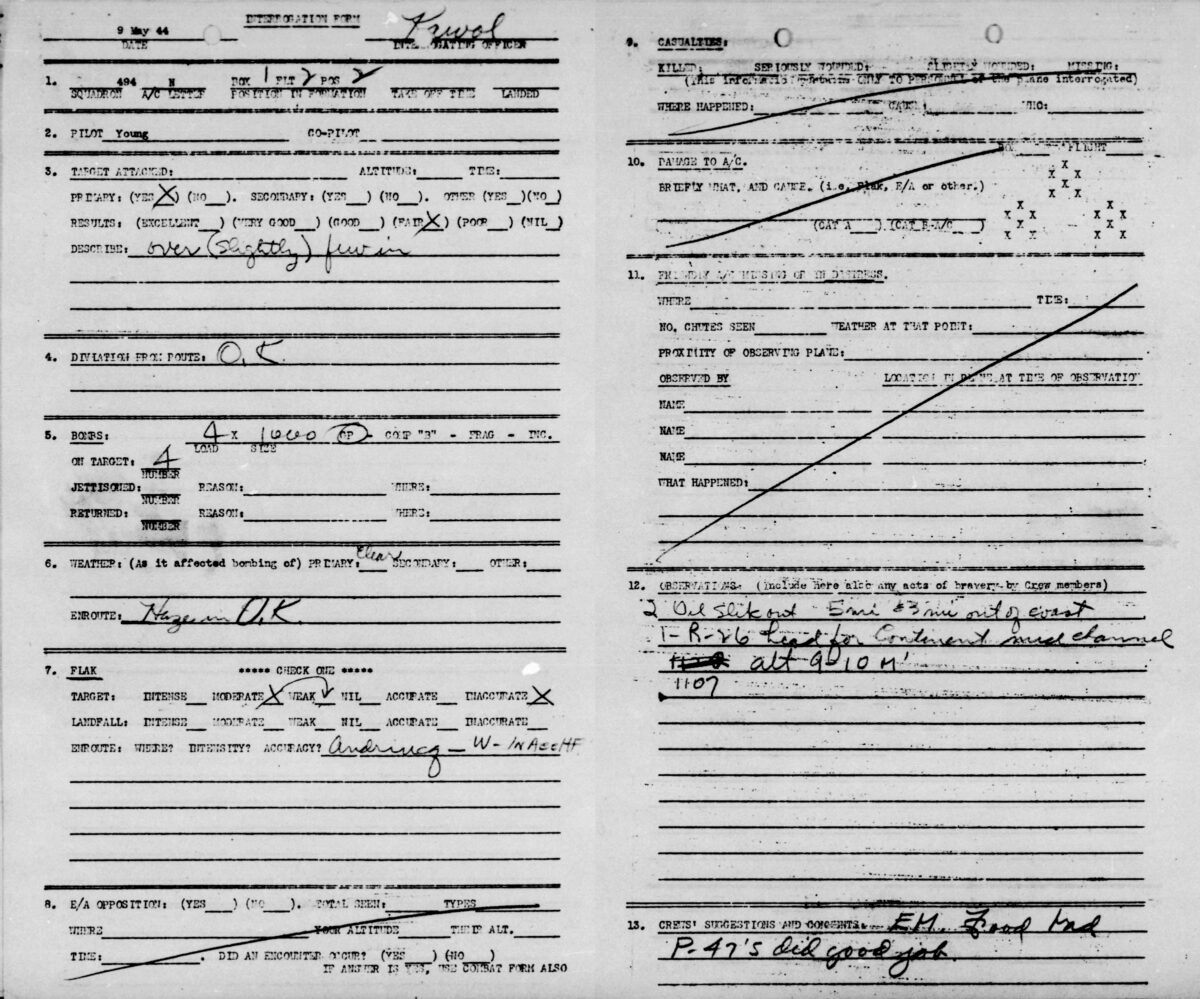
Flying in formation position 1-2-2, Young reports only fair results on the primary target delivering four 1000lb general purpose bombs. It was clear over the target but hazy over the U.K. They experienced weak, inaccurate flak but no enemy aircraft. He reported that their P-47 escort “did good job.”
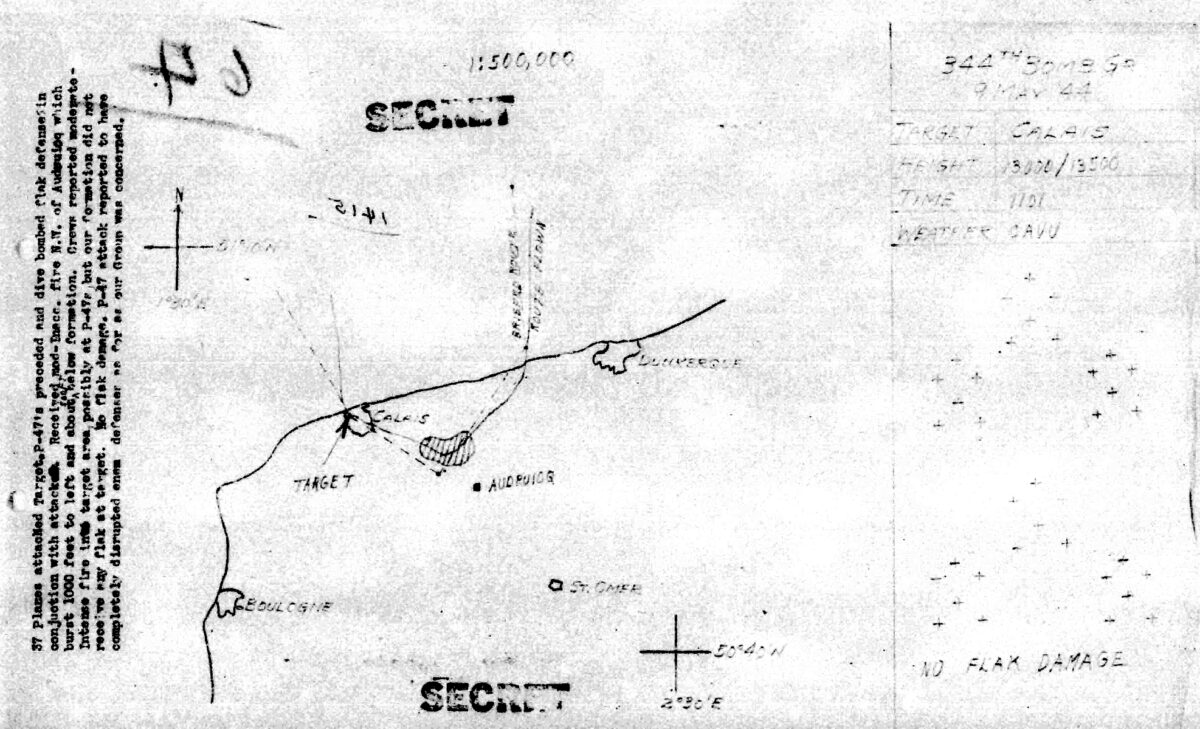
The map notes that the visibility was unlimited at the target when bombs were sropped at 11:01 am from 13,000ft. None of the plane received flak damage. The map inset states, ” 37 planes attacked target. P-47s preceded and dive bombed flak defenses in conjunction with attack. Received mod-inacc fire N.W. of Audpuioq which burst 1000 ft to left and about 500 ft below the formation. Crews reported moderate – intense fire into target area, possibly at P-47s, but our formation did not receive any flak at target. No flak damage. P-47 attack reported to have completely disrupted enemy defenses as far as our group was concerned.”
____________________
Second mission of May 9, 1944.
According to 344th Silver Streaks– “On May 9, Maquise coastal defenses, 38 planes dispatched by 6 planes, only dropping bombs, the others being unable to pick up and identify the target due to weather conditions that prevailed.”
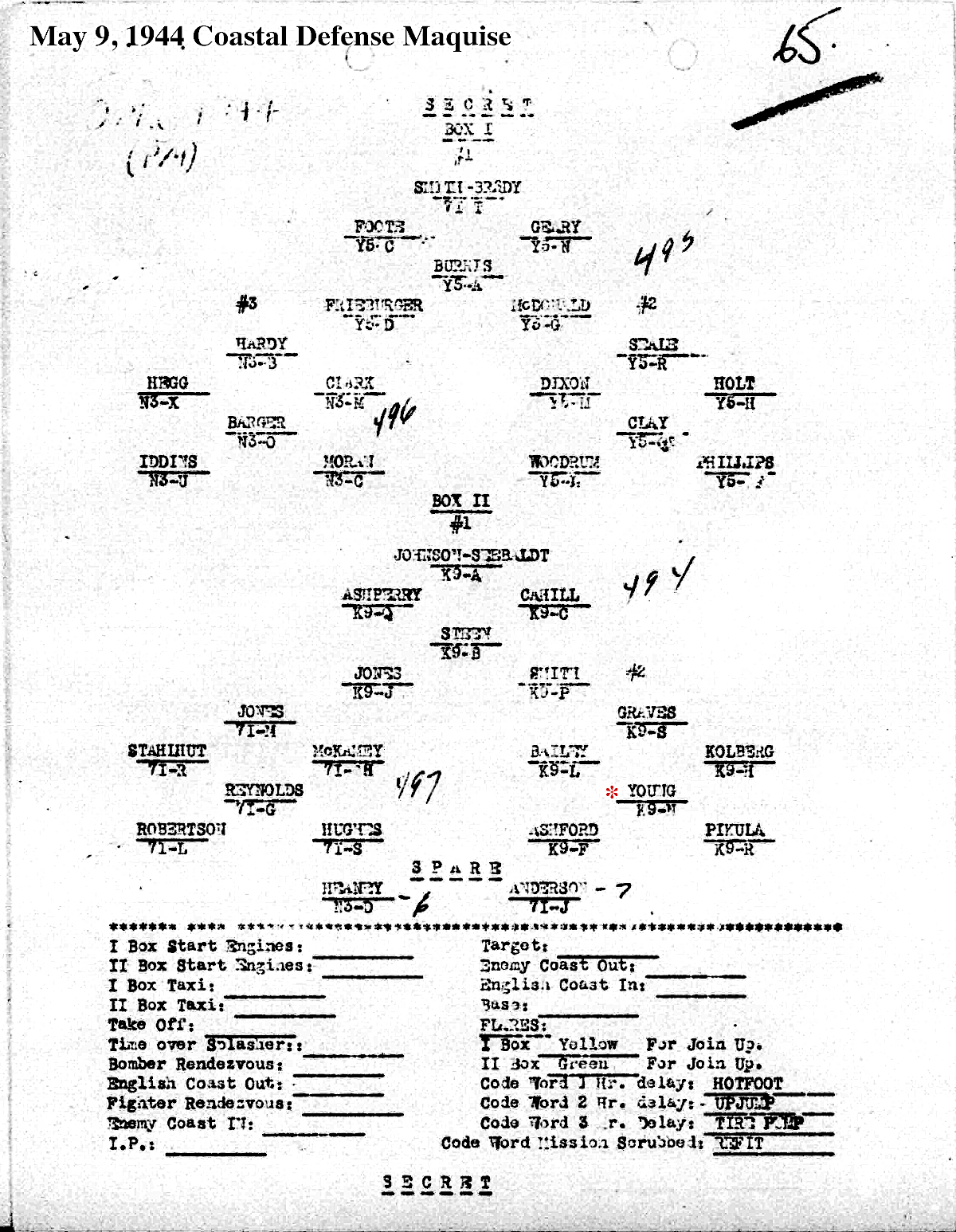
On the May 9, 1944 mission to attack coastal defenses near Maquise, France, Young’s plane flew in formation position 2-2-4.
The target was chosen to help deceive the Germans into thinking the invasion would be near Calais rather than Cherbourg.
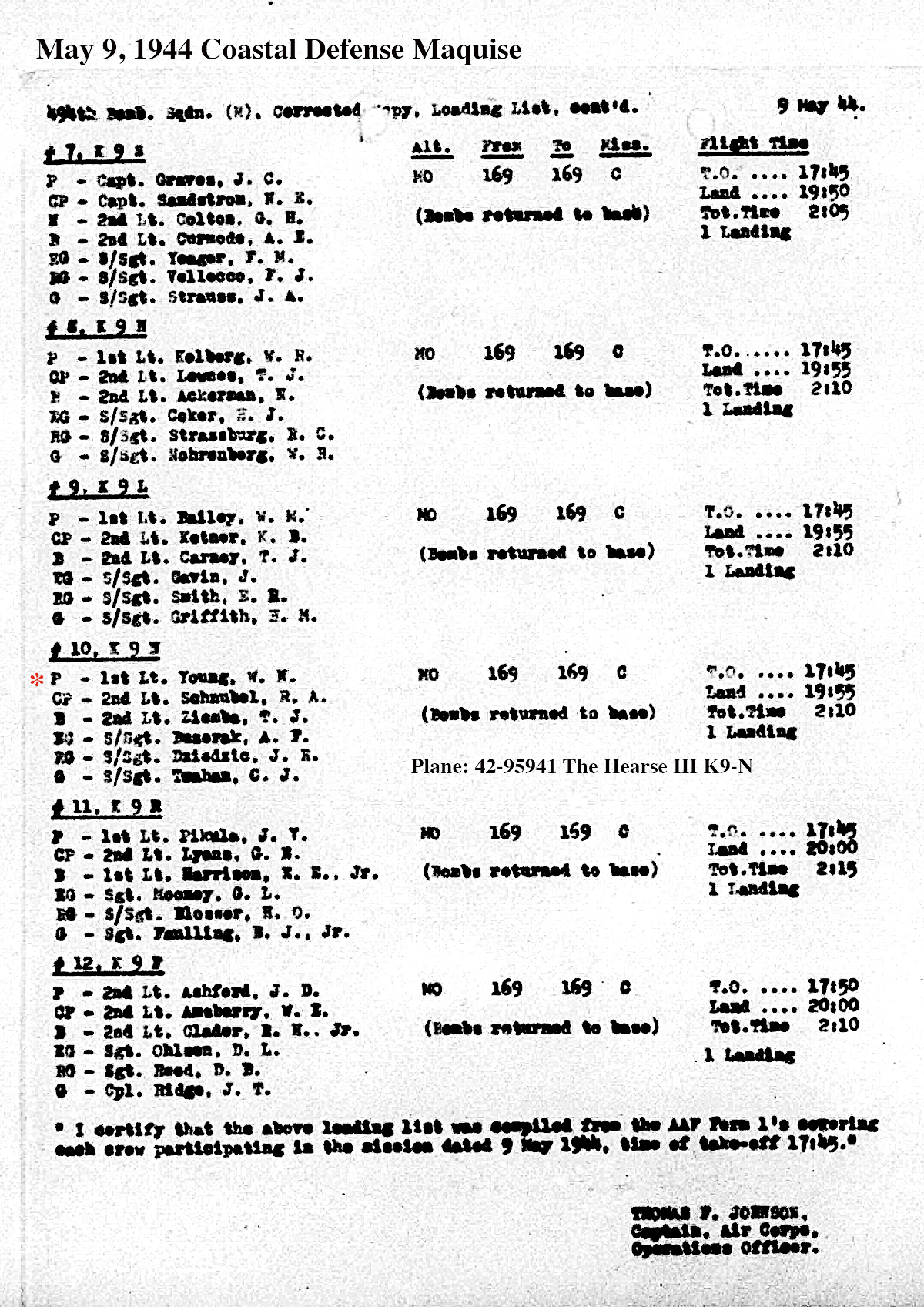
The crew included; Young – pilot, Schnubel – co-pilot, Ziemba – navigator/bombardier, Dziedzic – radio/gunner, Bazerak – engineer/gunner, Teahan – tail gunner.
Take off was at 5:45 pm and the landing at 7:55 pm. Their bombs were returned to base. They flew in 42-95941 The Hearse III K9-N.
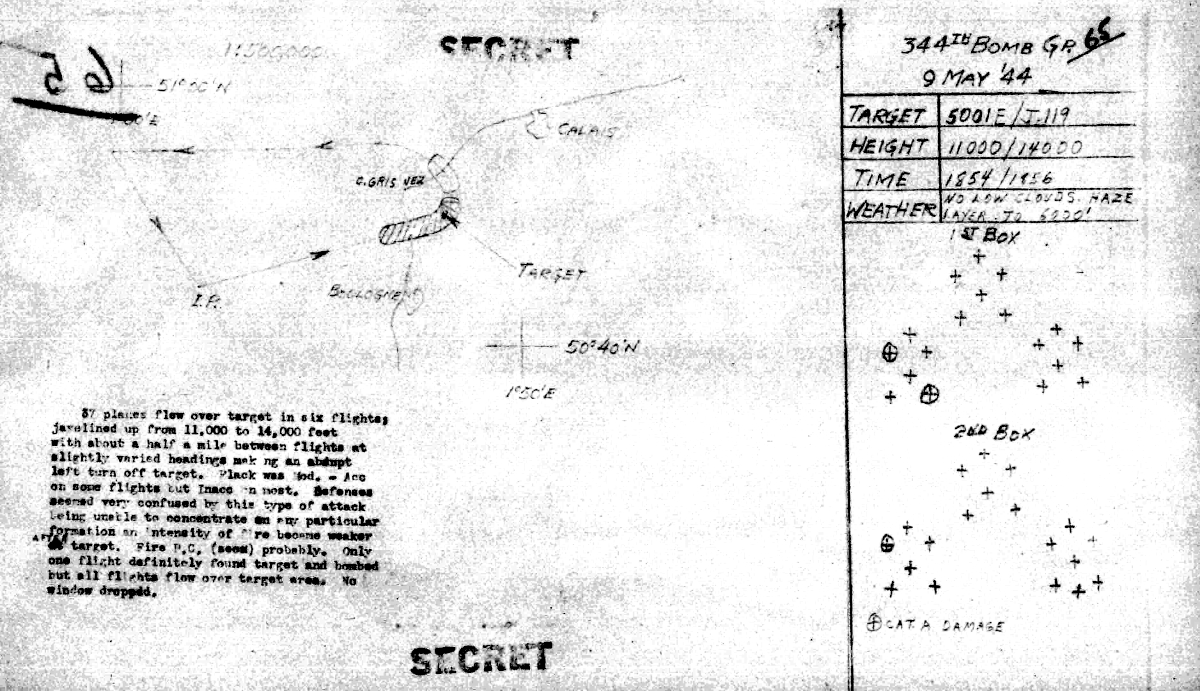
“37 planes flew over the target in six flights javelined up from 11,000 to 14,000 feet with about a half a mile between flights at slightly varied headings making an abrupt left turn off target. Flack was Mod – Acc onsome flights but inacc on most. Defenses seemed very confused by this type of attack being unable to concentrate on any particular formation an intensity of fire became weaker after target. Fire P.C. (seen) probably. Only one flight definately found target and bombed but all flights flew over target area. No window dropped.”
Bombing commenced at 6:54 pm from 11,000 – 14,000 ft. There were no low clouds but there was a haze layer to 6000 ft. Three planes suffered category A damage.
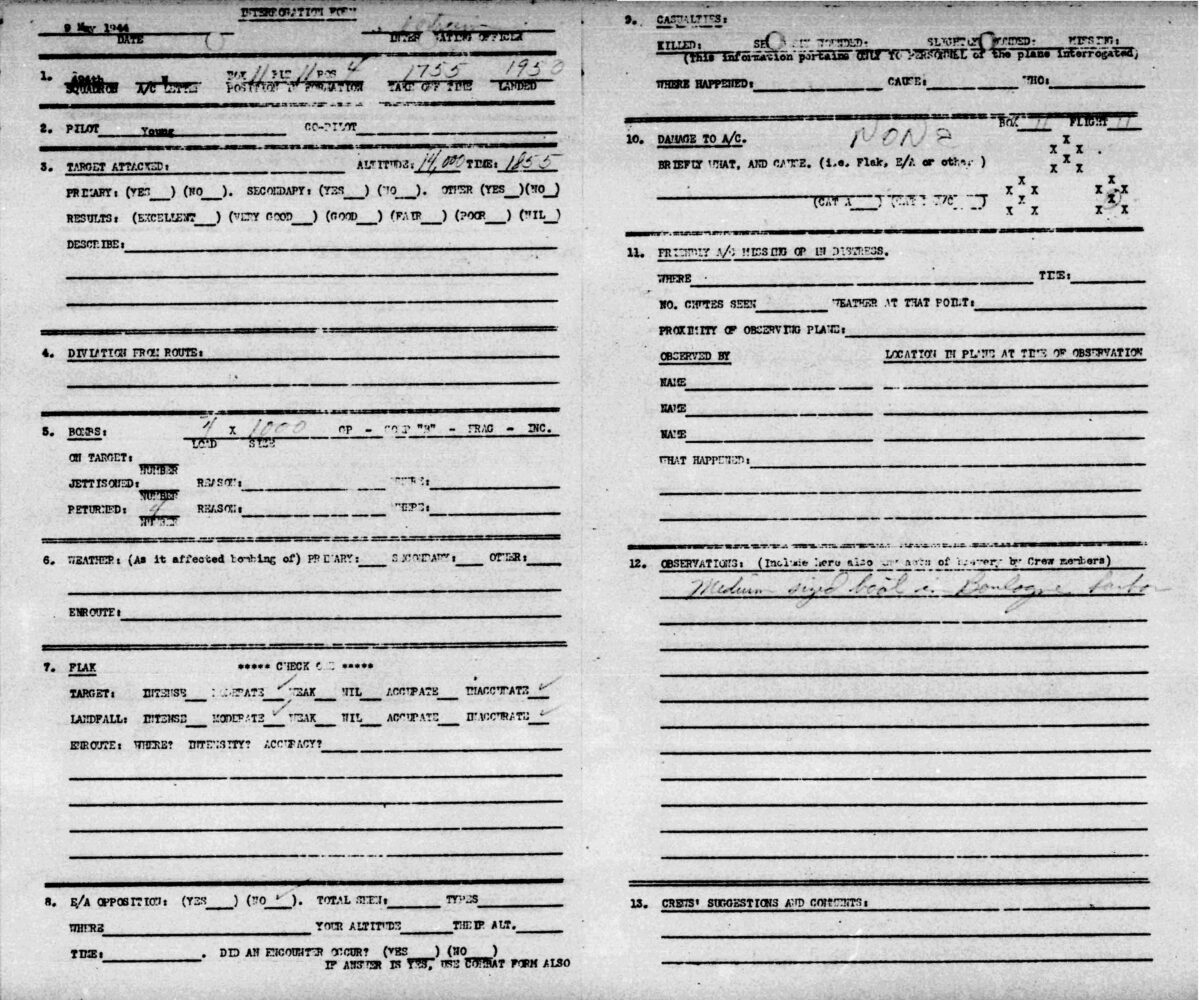
He took off at 5:55 carrying four 1000 lb bombs that were returned to base. He experienced moderate but inaccurate flak at the target and at landfall. Young and crew saw no enemy aircraft. There were no crew injuries or damage to the aircraft. They saw a medium sized boat in the Bologne Harbor.
——————————-


